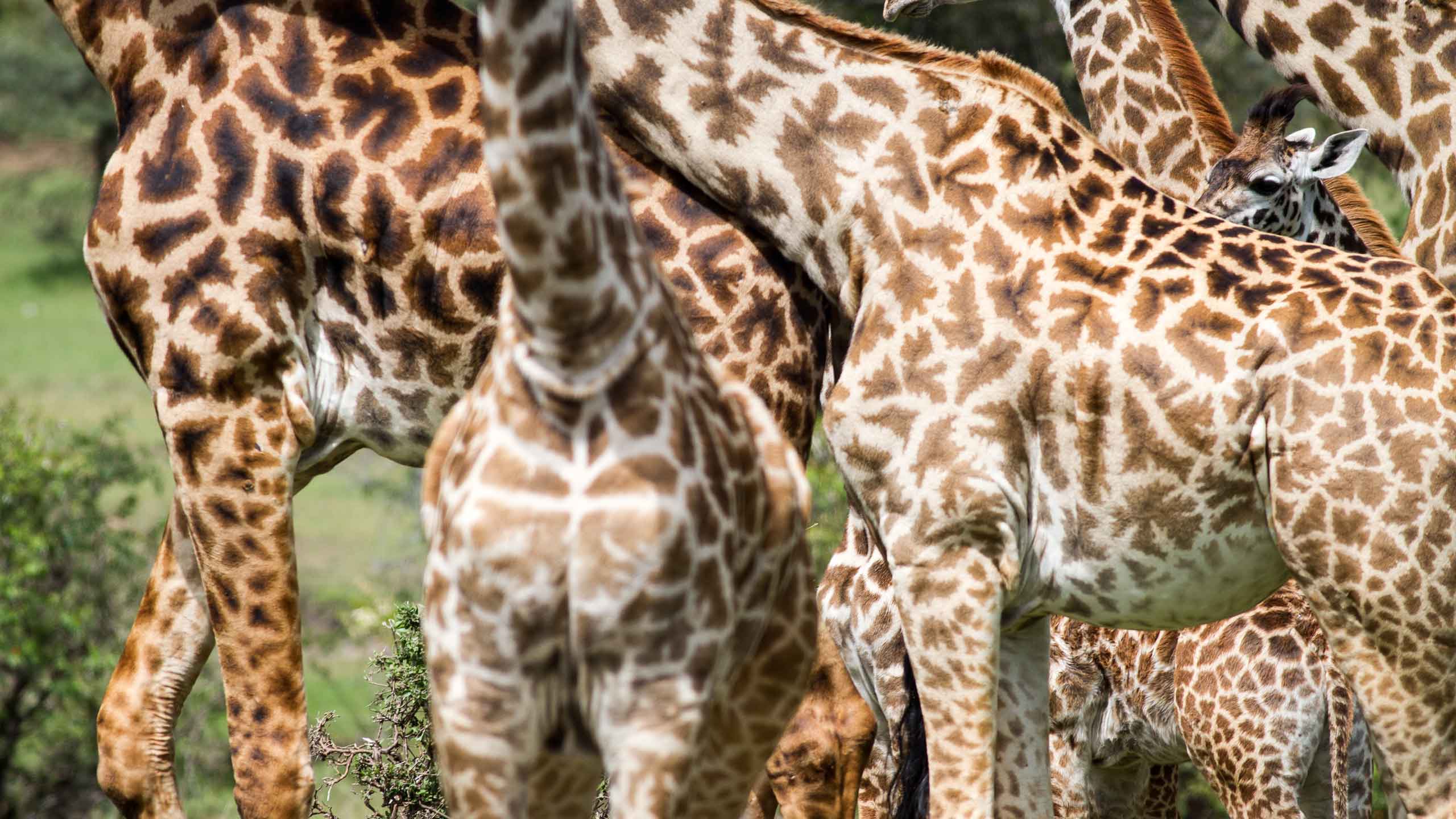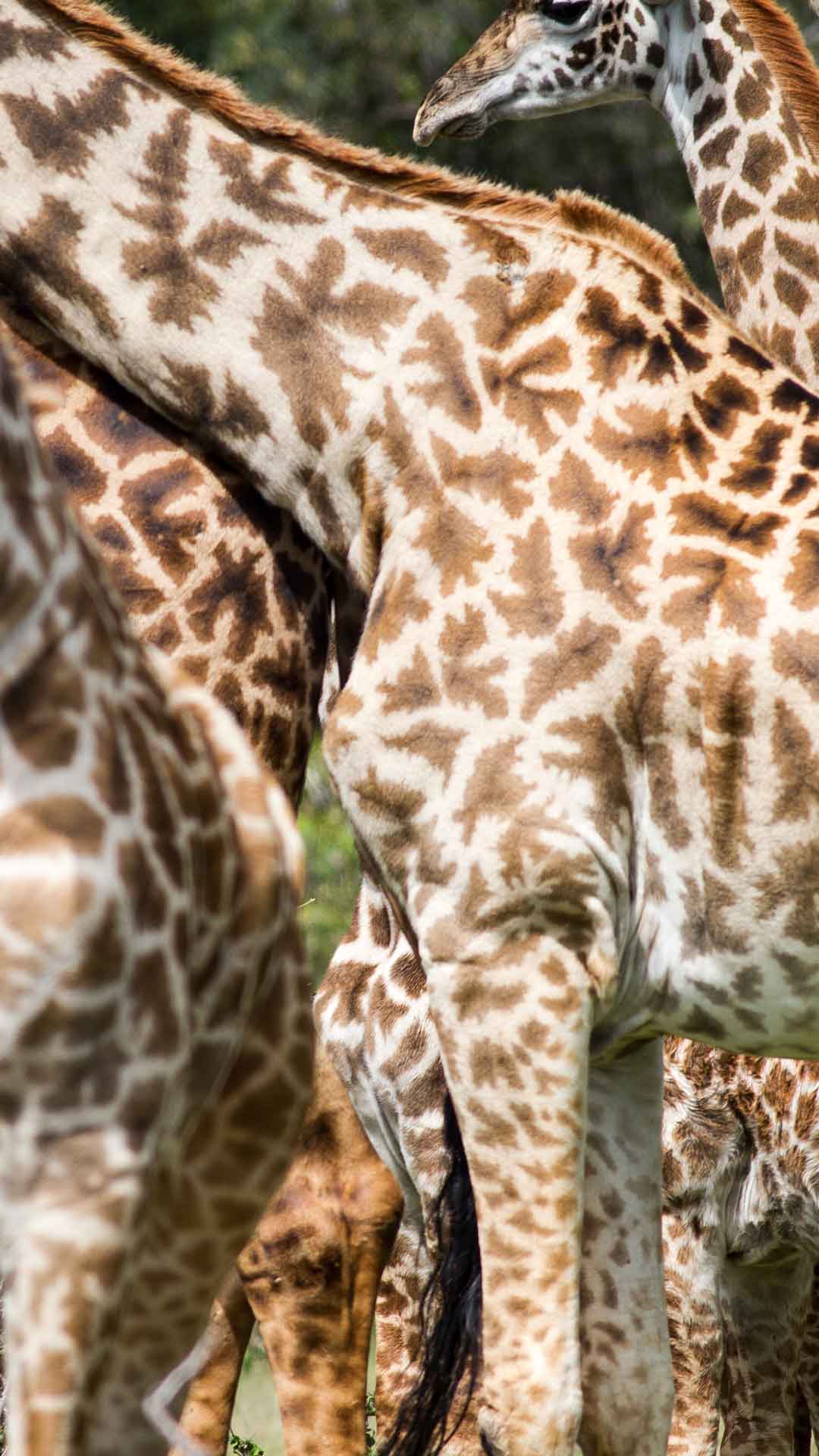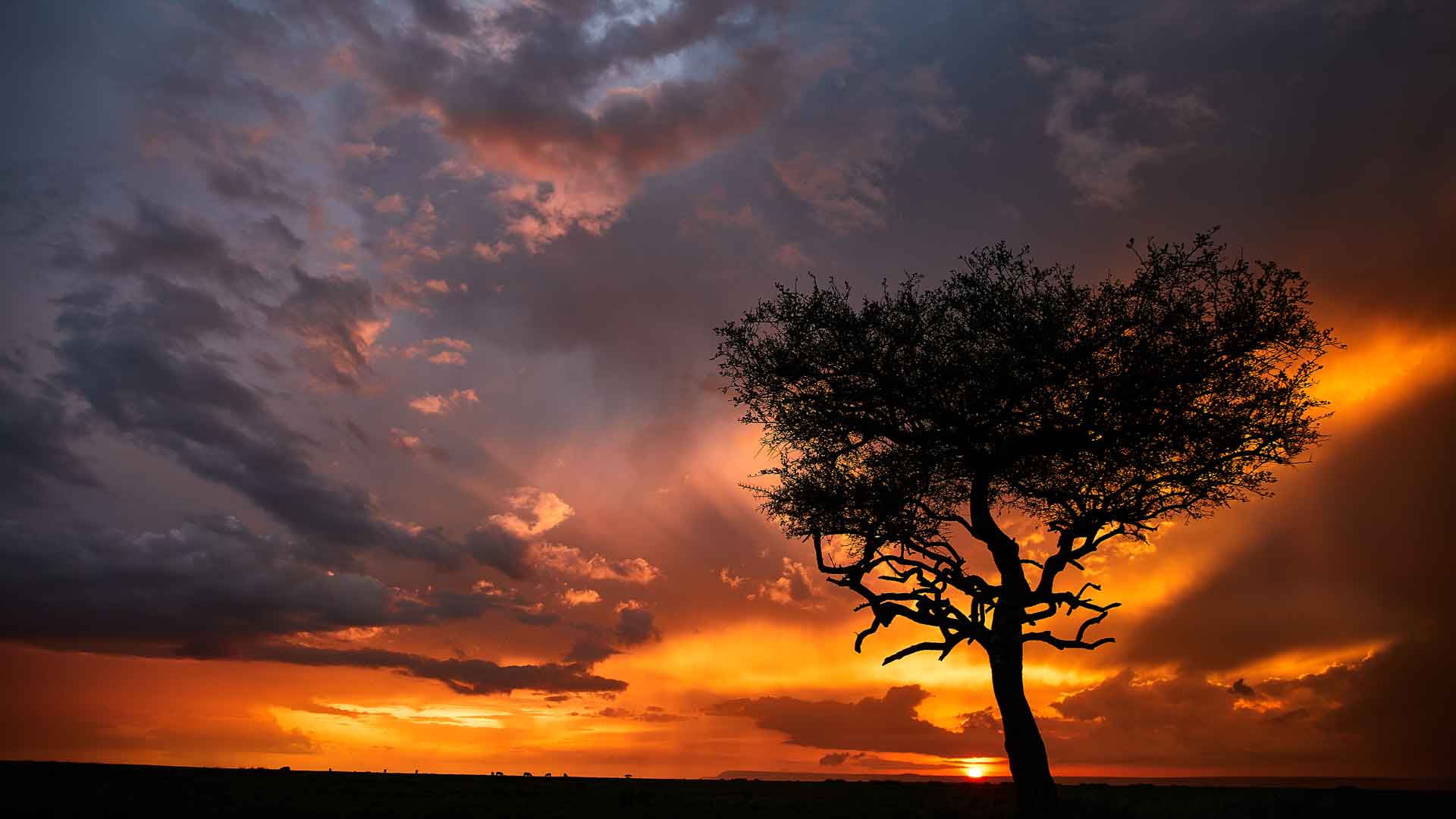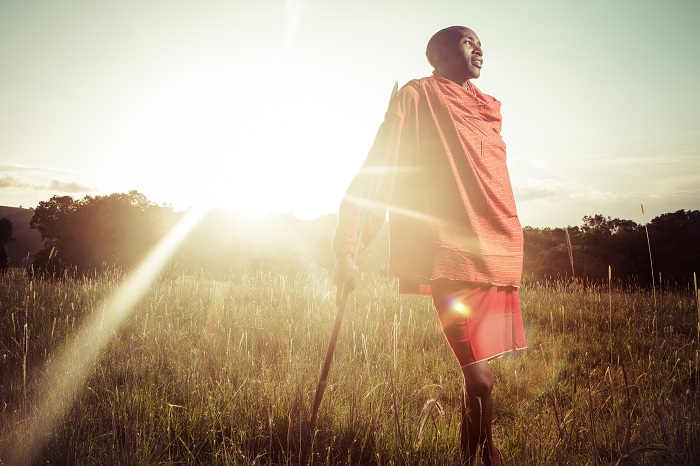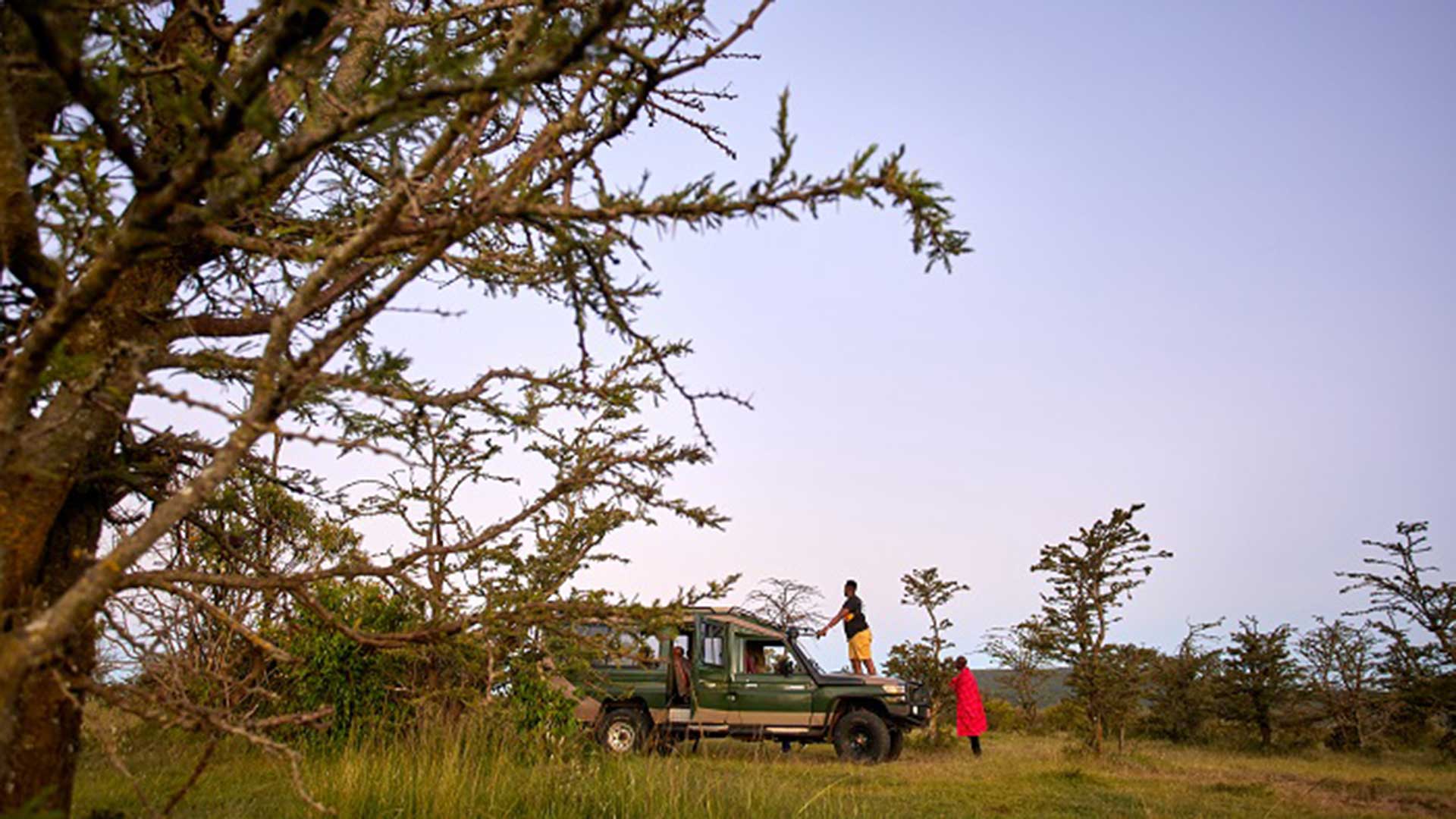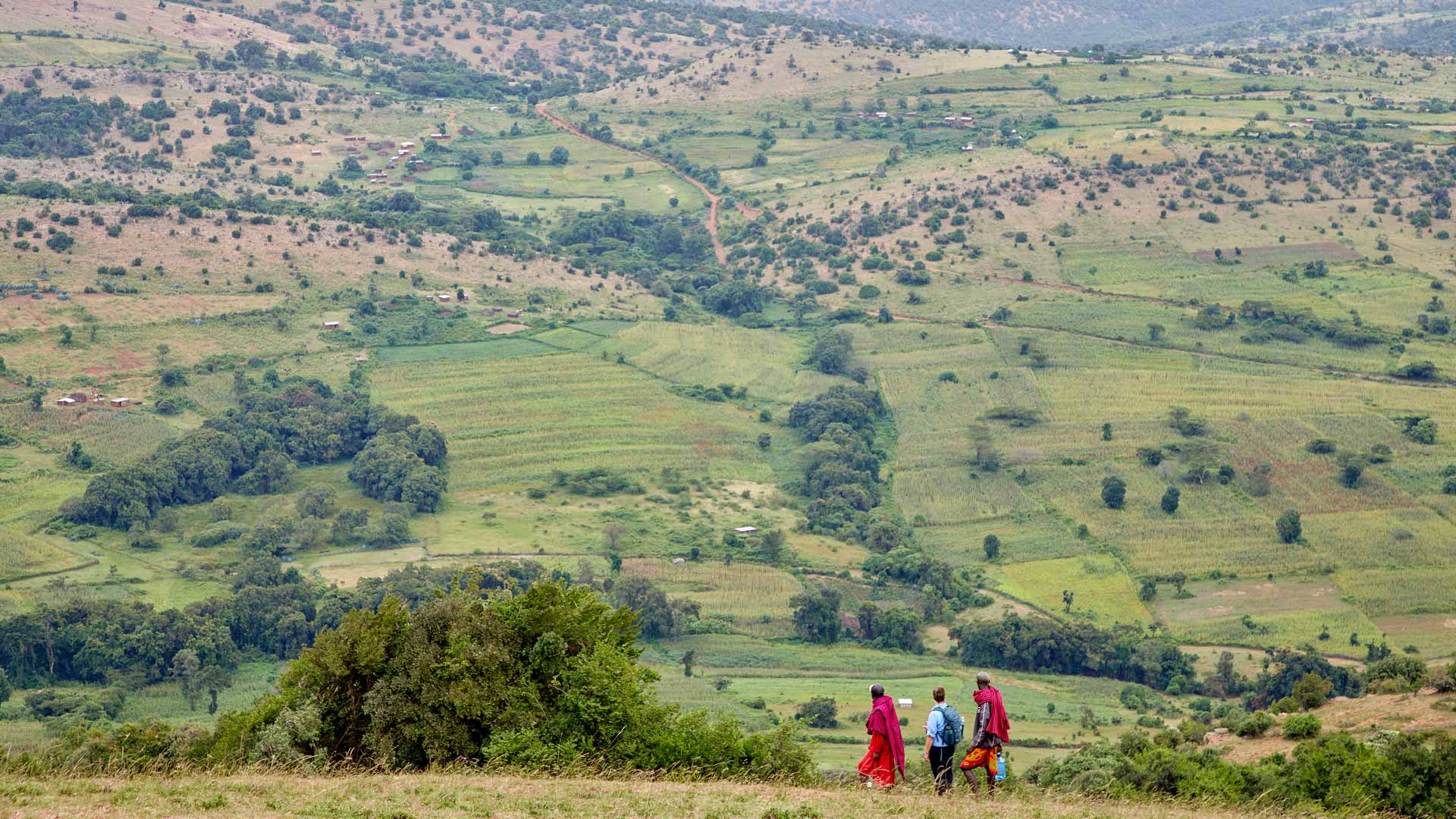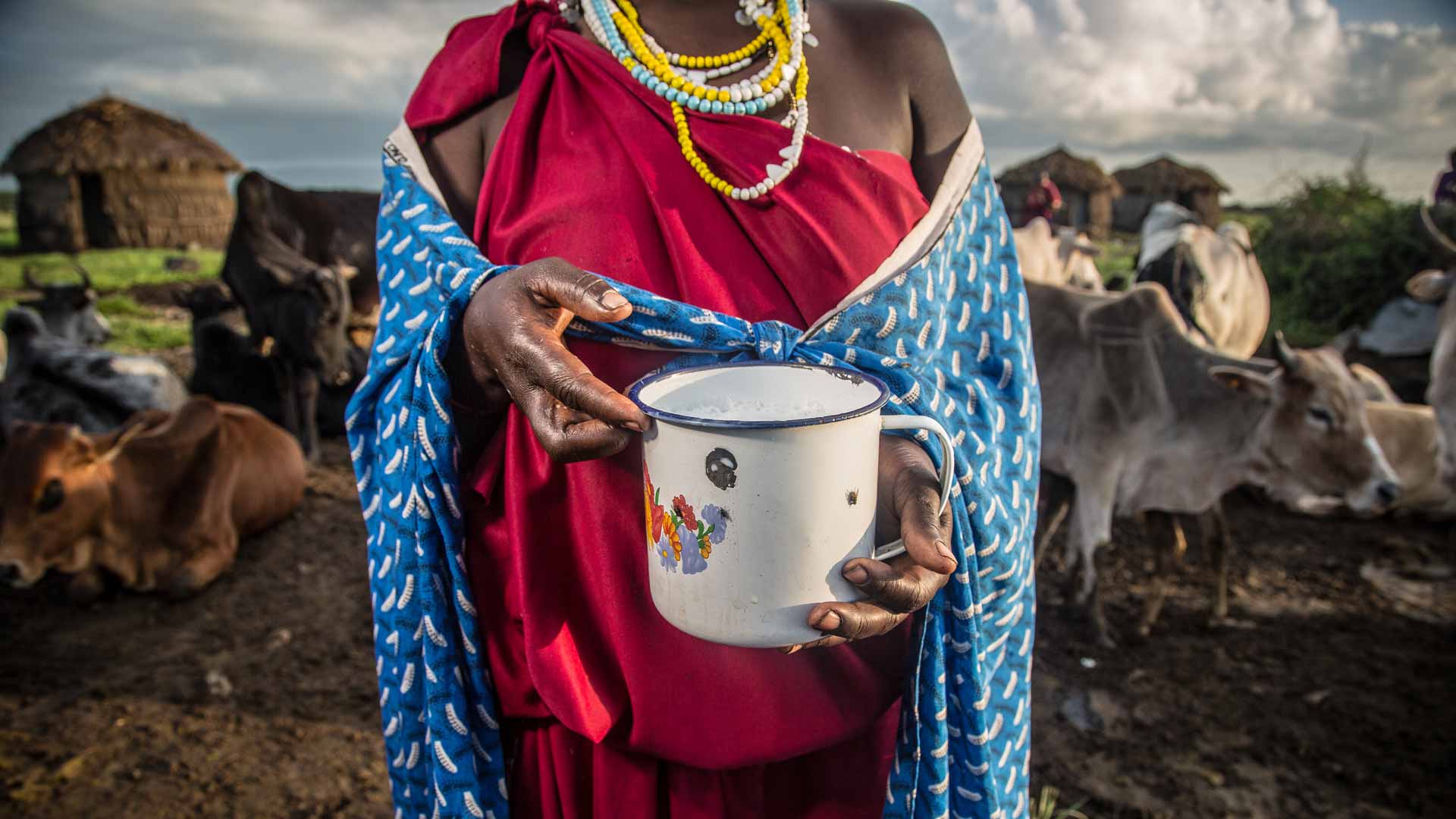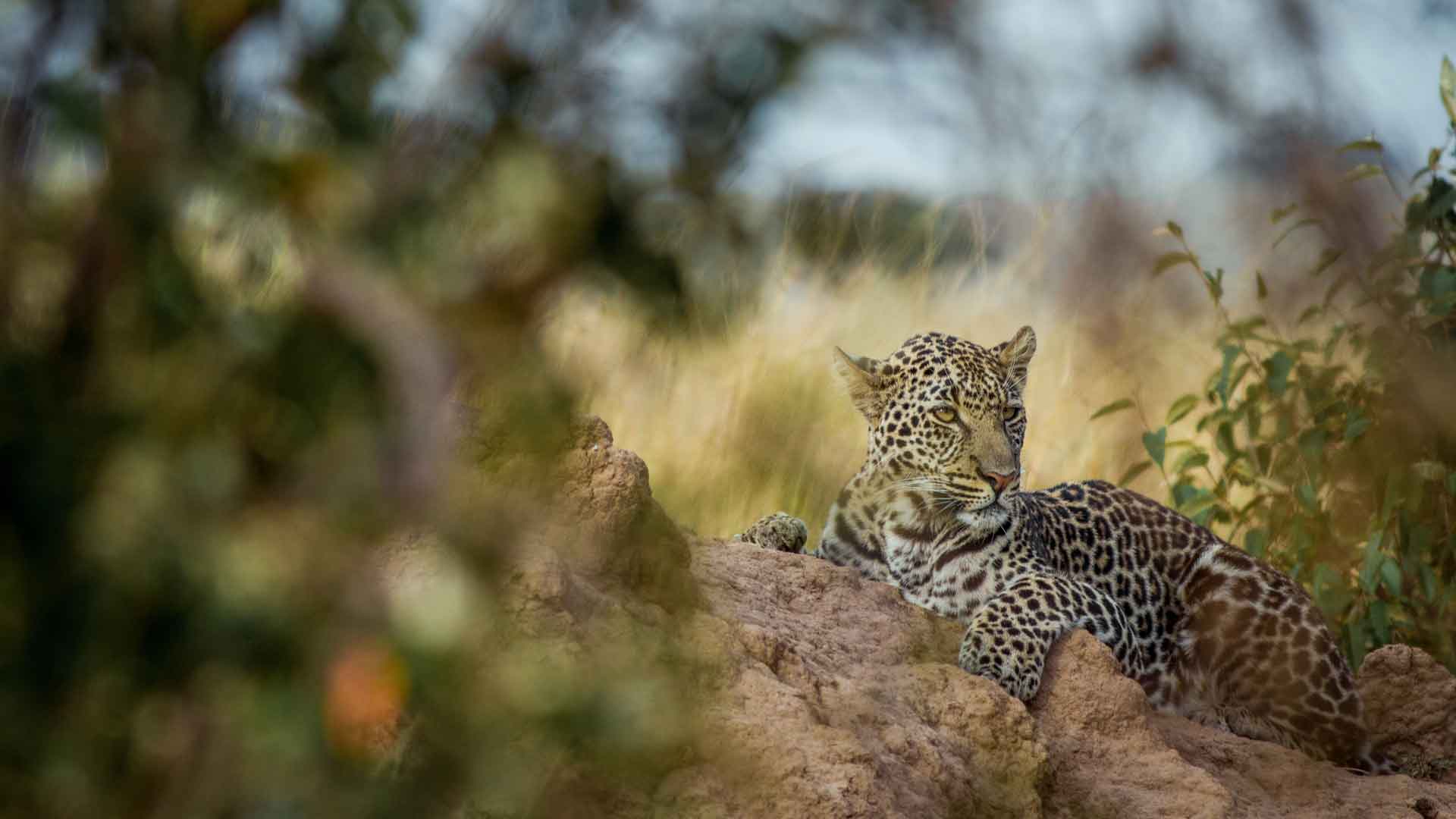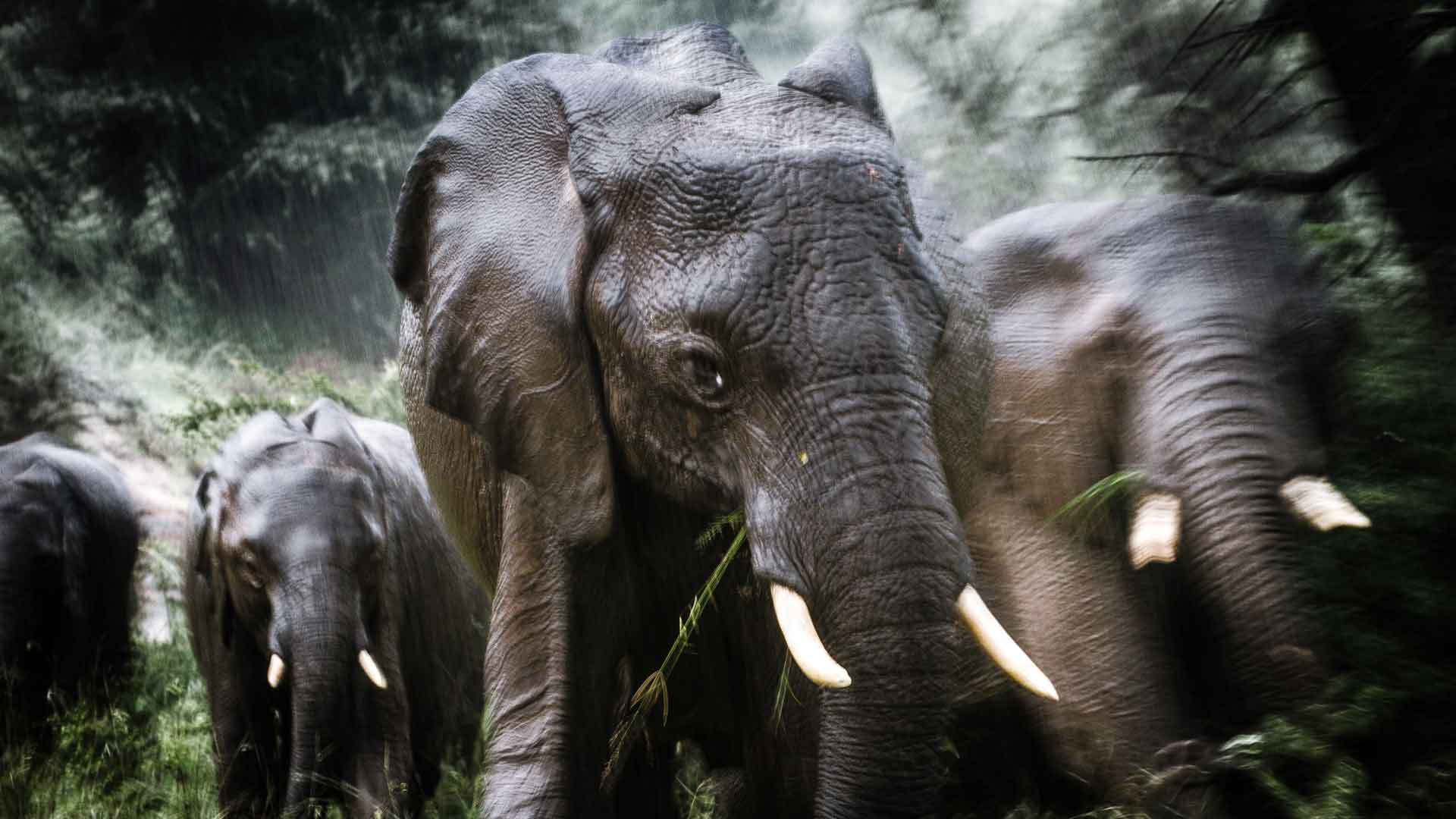The Nashulai Maasai Conservancy, situated right next door to Kenya’s famed Masai Mara National Reserve, is where Nashulai Journeys was born and has its spiritual heart. This vast 20,000 hectare slab of rolling savannah grasslands, bush, light forest and undulating hills ribboned in streams and rivers, teems with all the classic East African safari animals. The conservancy is home to four of the so-called Big Five (lion, leopard, buffalo, elephant) and, being open only to guests of Nashulai Journeys, our conservancy offers an exclusive, private safari experience and you will often have the entire area much to yourself. Activities on offer within the conservancy include classic driving safaris, thrilling walking safaris, bush camping, conservation in action programes and community activities.
Nashulai Journeys offers a range of day-trip safaris and activities within Nashulai Maasai Conservancy, as well as thrilling multi-day safaris focused on Nashulai Maasai Conservancy, plus the Masai Mara National Reserve and the gorgeous, but little known, Loita Hills, which are locally known as the Forest of the Lost Child.
All our day – and multi-day safaris offer unique experiences. And, as with everything that Nashulai does, community and wildlife come first, with all our safaris carefully tailored to ensure your visit is of benefit to the people and animals living in the areas we visit.
Four Day Safari
This classic four day safari gives a real insight into the Mara-Serengeti eco-system and the role that the conservancies play in conservation and community development. The longer time frame allows a slower, all absorbing approach and over the four days that you will be our guest you will visit the Masai Mara National Reserve and get a total overview of Nashulai Maasai Conservancy. As well as classic driving safaris there’s plenty of opportunity to set out and explore on foot and – for those with a taste for adventure – spend the night bush camping in a remote corner of the conservancy. You will get to meet lots of Nashulai community members, learn about our community development and conservation projects and get to spend times with Nashulai rangers or students at our guide training college. This is the safari for those who want to understand and not just see!
Itinerary

Arrive at Nashulai Maasai Conservancy and check into your luxury safari tent. After a three-course lunch set out on a safari within the Nashulai Maasai Conservancy in one of our customised safari vehicles to enjoy a wild chunk of East African wilderness virtually to yourself (only guests of Nashulai Maasai Safaris are allowed within the conservancy). The landscapes within the conservancy are very varied and a complete contrast to those of the nearby national reserve. Here, large, grassy plains are interspersed with areas of dense bush and throughout there are rivers, streams and pools of water which act as natural wildlife magnets. The wildlife populations in the conservancy are impressive, and you are certain to see large numbers of giraffe, zebra, baboons, impala, warthog, wildebeest and many more antelope and gazelle. Buffalo are commonly sighted as are hyenas and elephant. Of the cats there’s a resident pride of lions and cheetah are increasingly common.
As the day draws to a close stop for a sundowner drink at a viewpoint inside the conservancy. Return to camp for a three course dinner.
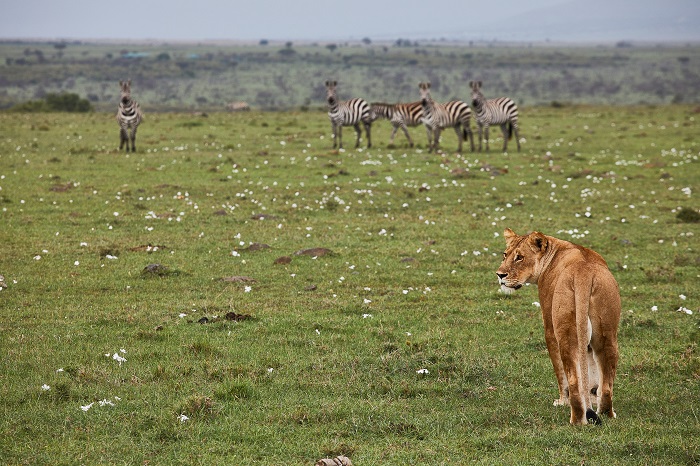
Your second day is dedicated completely to the Masai Mara National Reserve, a five minutes’ drive away from camp. After a big breakfast you will set out in one of our customised safari vehicles with an expert guide who has intimate knowledge of the Masai Mara National Reserve.
Our expert guide will reveal the wonder of the Mara grasslands to you. The Masai Mara is famous for its big cats. You would be very unlucky to not see at least one group of lions. Leopard and cheetah are both commonly seen as well. The other cats (caracals, servals and wild cats are present but very shy). You will also almost certainly see elephants often in sizeable herds. There are huge quantities of different antelope and gazelle (grants and Thompson gazelle, impala, and topi) and warthogs, zebra, giraffe, hyena, baboons and ostrich are everywhere. While the rivers are populated by crocodiles and hippos. Wildebeest are present year round but between July and early-October the population swells enormously as the million strong herds of migrating wildebeest arrive in the reserve from Tanzania’s Serengeti National park. Seeing such huge numbers of large mammals gathered together is a moment you’ll never forget.
For lunch on day two you can either have a picnic lunch within the reserve and spend the entire day out on safari. Or, you can return to camp for a three-course lunch followed by a rest and then either head back into the reserve for a late afternoon safari or you can do one of our cultural and conservation activities such as a short walking safari within the Nashulai Maasai Conservancy, or meet some of our rangers or visit a Maasai community among other options.
In the evening return to camp where you can enjoy a drink by the fire before a three-course dinner.

Your third day is dedicated completely to the Nashulai Maasai Conservancy. This time, after a filling breakfast you will set out to explore the Nashulai East Conservancy.
This area has very varied terrain that includes richly fertile river valleys lined by yellow bark acacia with excellent riverside bird-watching. There are also numerous hills covered in light woodland, which are a real favourite of elephant and buffalo. In fact, Nashulai East sits squarely on an elephant corridor and is one of the best of the Mara area conservancies in which to see these giant creatures. Herds of elephant thirty or more strong are common in this area. In the furthest corner of Nashulai East is the ‘secret plain’ a vast, open grassland with large numbers of grazers, including, in about January to March lots of wildebeest who come here to give birth. This abundance of prey means that the lion pride living here are commonly seen.
For those with a strong sense of adventure we can arrange to spend the night bushcamping in small dome tents close to this ‘secret plain’ and a very traditional Maasai village. You will get to enjoy an unforgetable night in the wilderness listening to the sounds of passing wildlife and meet some of the people who live in the village close to where we camp. You may even be able to help with the herding, and milking, of livestock. For those wishing to do the bushcamping experience we require at least 72 hours advance notice.
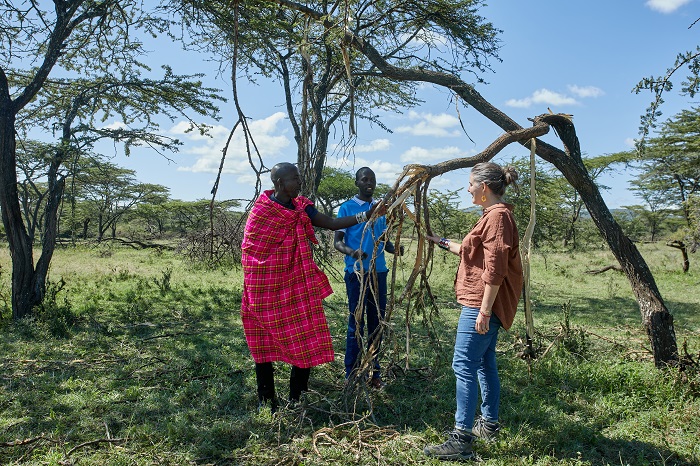
Your fourth day on safari is dedicated primarily to learning about community and conservation. You will begin by heading out on foot patrol with some of the Nashulai rangers. They will explain the importance of their work and go through their day to day activities. They will teach you how to track wildlife, set camera traps, talk to local communities. Every day is different with the rangers. Afterwards you will visit the Nashulai Guide Training College and learn first-hand from students and pupils what it takes to be a wildlife guide in Kenya. After a lunch shared with students and teachers we set out to visit the local communities surrounding Nashulai. You will get to hear how the conservancy benefits the local Maasai community and visit some of our projects. These range from education and health projects to women empowerment projects.
In the late afternoon you will be driven back to Nairobi (or we can drive you to your next destination if you’re safari is not at an end). It’s also possible to reserve an extra nights stay at Nashulai and then leave after breakfast on the fifth day.
This four day/three night safari includes
price does not include
Prices for our four day safaris vary on the number of people in your group and which of our two camps you choose to stay in.
A four day/three night safari based on one person travelling alone starts at US$2460. A four day/three night safari based on two people sharing accommodation starts at US3620.
Loita Forest to Nashulai Maasai Conservancy Walking Safari
Are you ready for an experience and an adventure you’ll never forget? Imagine the thrill of walking for days on…
Are you ready for an experience and an adventure you’ll never forget? Imagine the thrill of walking for days on end through the heart of one of East Africa’s great wilderness areas and camping out at night under a million stars while falling asleep to the sound of the bush. This extraordinary week long walking safari will take you through a huge variety of landscapes and habitats which are home to a long list of birds and animals. Starting in the cool, jungle-like forests of the little known Loita Hills (also known as the Forest of the Lost Child), where birds and animals more closely associated with Central Africa can be found, we descend downward through tiny patchwork fields of maize and wheat, past small Maasai villages and farmsteads where a traditional Maasai lifestyle clings on. Then, rising slightly again, we cross open moorlands where groups of wildebeest warily watch our passing. Finally, we drop down into the hotter, drier grasslands and scrub of the Nashulai Maasai Conservancy where we stride across the savannah as herds of zebra and giraffe warily watch us. But this is not just a natural world walking safari. This is an undiluted cultural safari into one of the remotest corners of Kenyan Maasai land where a traditional Maasai culture just about clings on. For anyone who wants to combine the thrill of long distant walking with stunning landscapes, superb wildlife and an unforgettable human dimension, then our seven day Loita Forest to Nashulai Maasai Conservancy Walking Safari is the biggest adventure in East Africa.
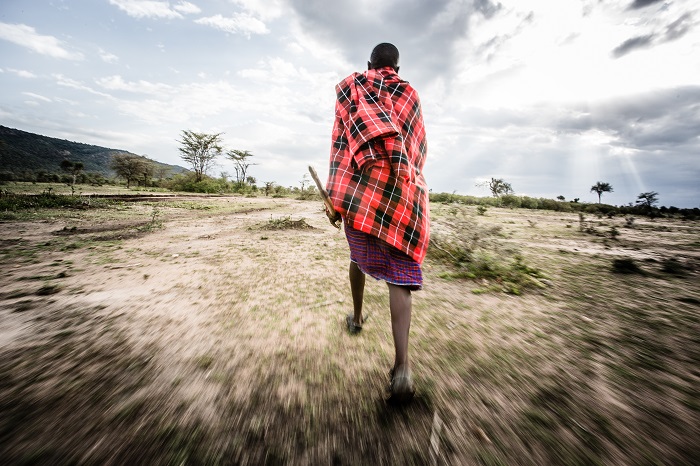
The landscapes here are gently undulating rather than mountainous and the climate ideal for hiking. The walking is of moderate difficulty (we can also tailor this tour to make it easier or harder depending on your requirements). Most days you will walk for around 5-6 hours a day. Most nights are spent camping in small two-person dome tents either in the bush surrounded by the sounds of the wild or close to highly traditional Maasai farmsteads and villages. Most of the baggage will be carried by donkeys but you will need to carry a small backpack with your day to day equipment in it.
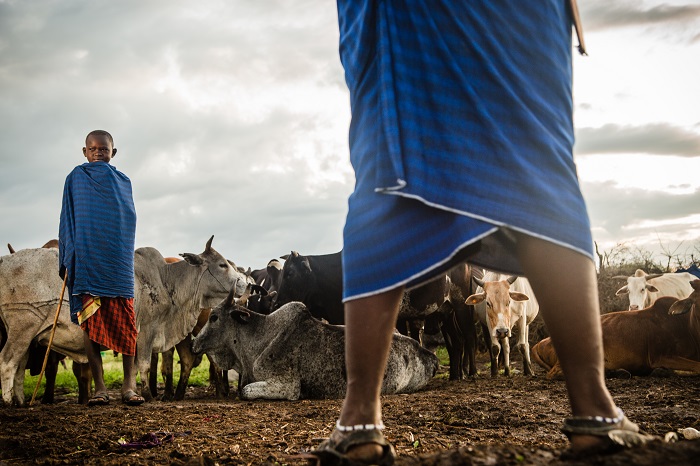
We make this walking safari as comfortable as we can. Tents contain air mattresses and proper bedding, we supply camping chairs and tables, a toilet and shower tent and you will be accompanied by a dedicated cook who will whip up delicious meals (lunch is normally a picnic eaten in the shade of a tree, but breakfast and dinner are lavish cooked meals) and serve you snacks and drinks at the end of a long days hiking.
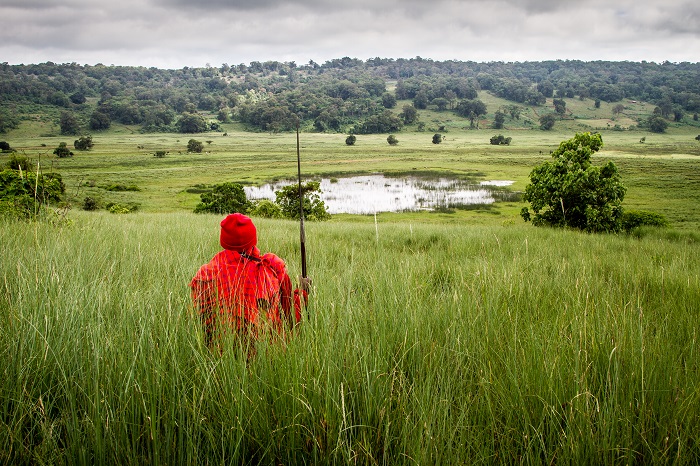
However, no matter how comfortable and safe we make this walking safari it remains pure exploration. No journey here is ever the same. There are no nicely manicured and signed trails, no set route and we have no idea what we might find around the corner. Our expert, highly experienced, local walking guides know the area inside out and will use their knowledge to vary the route each and every time depending on your requirements and interests. But, what never varies though is the total immersion into traditional Maasai culture and the sheer thrill of walking alongside megafauna.

We can also tailor the duration of this safari. If you don’t have a whole week at your disposal then we can shorten the walk a little. By contrast, if you want to devote more time to this once in a lifetime adventure then we can walk for as many days as you wish!
However long you take, walking from the Forest of the Lost Child to the edge of the Masai Mara is an adventure that you will one day recount to your grandchildren.
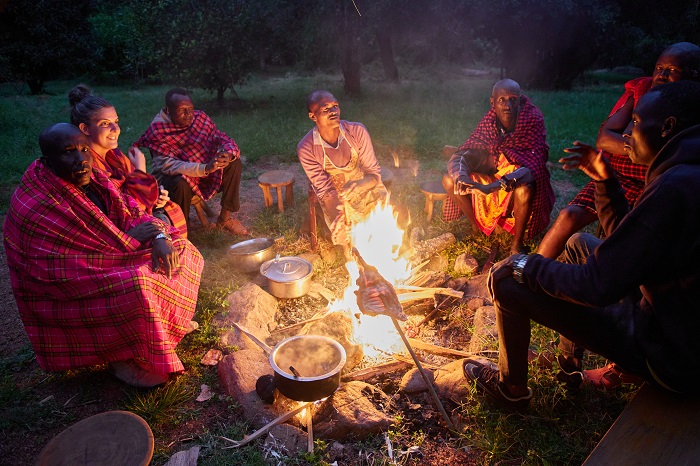
Itinerary
After an early breakfast at your Nairobi hotel you will set out on the long but fascinating drive to our simple tented camp deep within the Loita Forests. From Nairobi it’s an eight hour drive, but the variations in landscapes – from rich fertile farmland to the volcano dotted floors of the Rift Valley, open savannah grasslands and up into increasingly forested landscapes – means that there’s always something to please the eye on this drive. We will stop for lunch around the halfway point. Snacks and drinks will be served on arrival. If we reach our camp in the Loita forests early enough then a short forest walk of an hour or two is an ideal way to stretch the legs. Otherwise you can visit the award-winning local school we support (term time and school hours only) or the women’s jewellery project supported by Nashulai Journeys. Over dinner your guide will discuss the programme for the coming days.
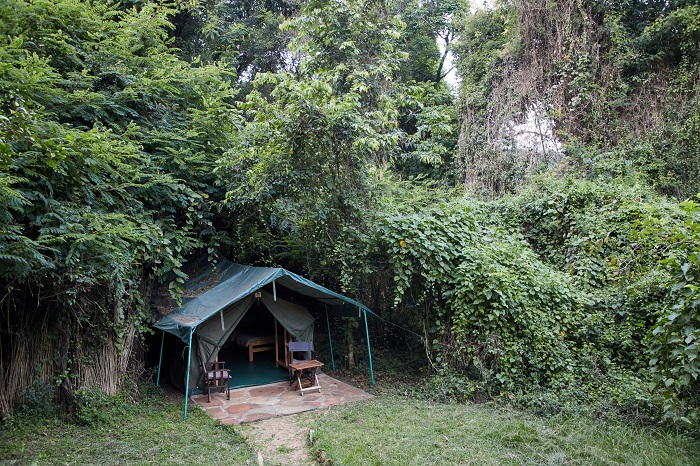
Today we will spend a full-day hiking through the Loita forests. We will head up to lofty summits and through traditional Maasai villages where the welcome is warm and outside visitors rare. Our expert local guides will point out colobus monkey, hornbills, and turacos among a wealth of other bird and animal life. We will also walk to a waterhole deep in the forest where rust-red forest buffalo (a different species to the buffalo seen in the savannah plains), bushbuck, forest pigs and even elephant congregate for a drink. As well as wildlife, the walk takes in tiny farming villages where the local Maasai might even invite us inside their compounds to drink tea. A picnic lunch will be eaten in the forest or at one of the viewpoints. The exact length and difficulty of the walk can be tailored according to the ability and wishes of the group.
Heading back to our tented camp we will visit the small and very colourful local market town which brings in Maasai from across the region and even from nearby northern Tanzania.
There will be some time to relax and enjoy this wonderfully peaceful setting before sundowner drinks and dinner.
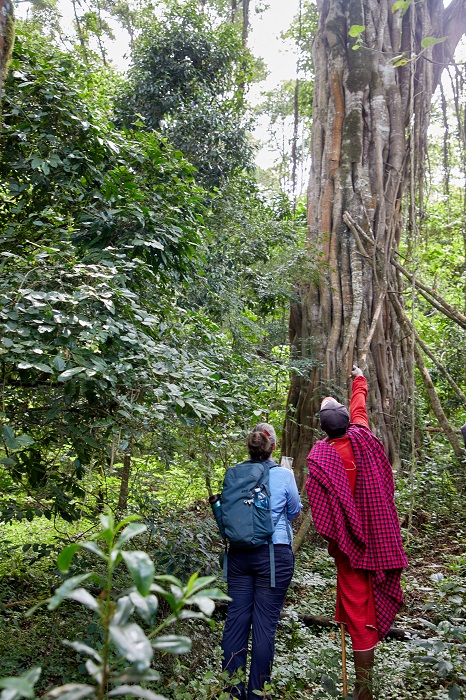
Let the adventure begin! After breakfast on day three we will load up the donkeys, lace up the hiking boots and head out on the four day trek that begins in the jungle like forests of the Loita Hills and ends in the animal spotted grasslands of the Nashulai Maasai Conservancy right on the border of the famed Masai Mara National Reserve. Along the way will be magical encounters with a wide array of wildlife. Zebra, impala, wildebeest and Thomson’s gazelle are the most commonly encountered larger creatures, but there’s always a wealth of varied birdlife to be seen (our head guide for these walking safaris is highly knowledgeable on the local bird life) and many smaller creatures, from mongoose to lizards, praying mantis to dung beetles, that you’d likely never notice from the confines of a safari vehicle. But this adventure isn’t just about the wildlife. People are perhaps even more prominent in this journey than wildlife. The Loita Forests, and the hilly lands leading down toward Nashulai Maasai Conservancy are probably the most traditional remaining corner of Maasai land in Kenya. And, if you’re open to the invitations, you’re likely going to meet a remarkable cast of individuals from traditional healers to genuine Maasai moran (warriors), as well as dozens of people still living a traditional shepherding lifestyle. Everything you see here is the real thing. We are far removed from any established tourist trail. What you will witness here is unfiltered traditional Maasai culture as it crashes headlong into a modern, connected world. And so, as well as meeting representatives of the old ways you will also meet the highly educated, skilled and worldly wise new generation of Maasai. The teachers, political leaders, doctors, conservationists and others who are reshaping contemporary Maasai life and culture. As none of these people are directly connected with Nashulai Journeys we cannot guarantee who you will meet as you walk, but one thing is for sure: The sight of a tourist walking through this remote corner of Maasai land is so unusual that anyone you encounter is certain to want to stop and chat.
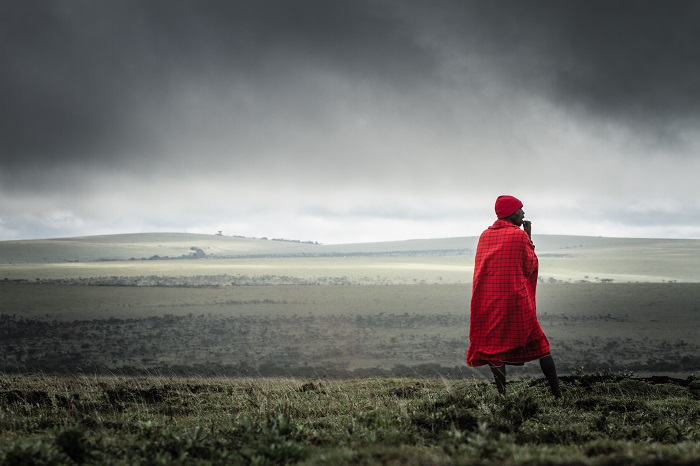 On most days we will walk for around five hours. The pace is slow and relaxed with plenty of time to stop, chat, drink tea with locals or veer off our intended route to climb a nearby hill or pause to watch a chameleon blending and melding into its surroundings. Lunch will normally be a picnic but when we get to our chosen night stop snacks and drinks will be served while our team get to work setting up camp for the night. Later in the evening a full hot dinner will be served and you’ll be entertained by your guides with stories of days past. Most nights you’ll go to bed early and wake with the dawn sun for a filling breakfast as camp is packed up and another day of unknown possibilities unfolds.
On most days we will walk for around five hours. The pace is slow and relaxed with plenty of time to stop, chat, drink tea with locals or veer off our intended route to climb a nearby hill or pause to watch a chameleon blending and melding into its surroundings. Lunch will normally be a picnic but when we get to our chosen night stop snacks and drinks will be served while our team get to work setting up camp for the night. Later in the evening a full hot dinner will be served and you’ll be entertained by your guides with stories of days past. Most nights you’ll go to bed early and wake with the dawn sun for a filling breakfast as camp is packed up and another day of unknown possibilities unfolds.
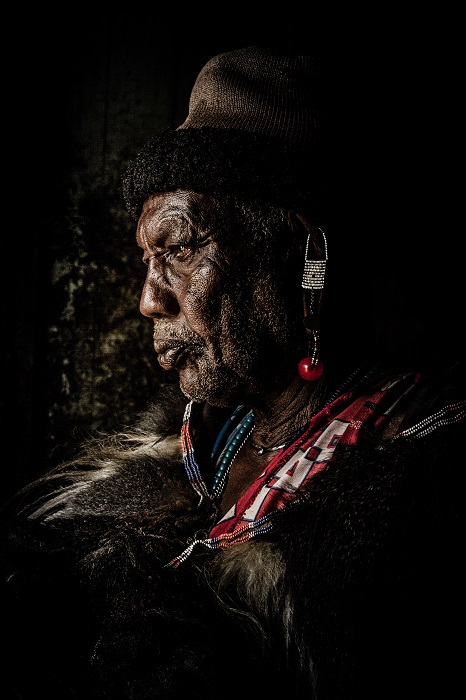 Wildlife is an ever present feature of these walks and although there are buffalo, elephant, lion and leopard out there for most of this walk it’s very unlikely that you’ll encounter any of these potentially dangerous creatures on foot at close quarters. The last day though takes us straight through the eastern half of the Nashulai Maasai Conservancy and here the wildlife – including large numbers of elephant and prides of lion – are abundant.
Wildlife is an ever present feature of these walks and although there are buffalo, elephant, lion and leopard out there for most of this walk it’s very unlikely that you’ll encounter any of these potentially dangerous creatures on foot at close quarters. The last day though takes us straight through the eastern half of the Nashulai Maasai Conservancy and here the wildlife – including large numbers of elephant and prides of lion – are abundant.
On the evening of Day Six we will arrive at the Oldarpoi Camp within the Nashulai Maasai Conservancy. A hot shower, three course dinner and a night in one of our luxury tents awaits.
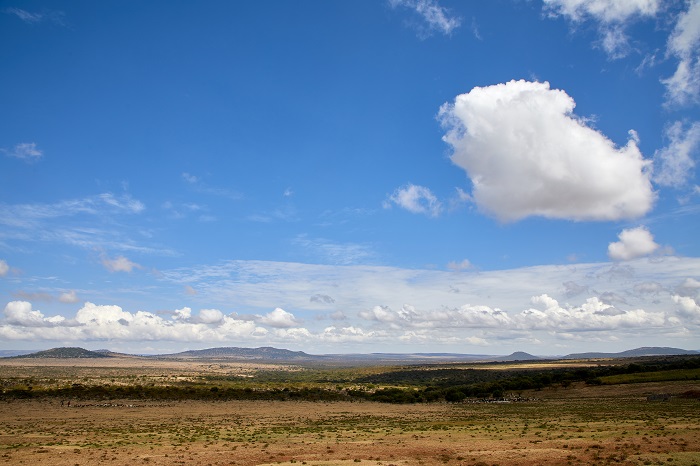
Removing the hiking boots you now slip into the comfort of a customised private safari vehicle for a full morning’s game drive either within the Nashulai Maasai Conservancy or the nearby Masai Mara National Reserve (the choice is up to you). After ogling lions and elephants all morning we head back to camp for a final lunch before driving back to Nairobi (4hrs; other drop off destinations available) where this extraordinary adventure comes to an end.
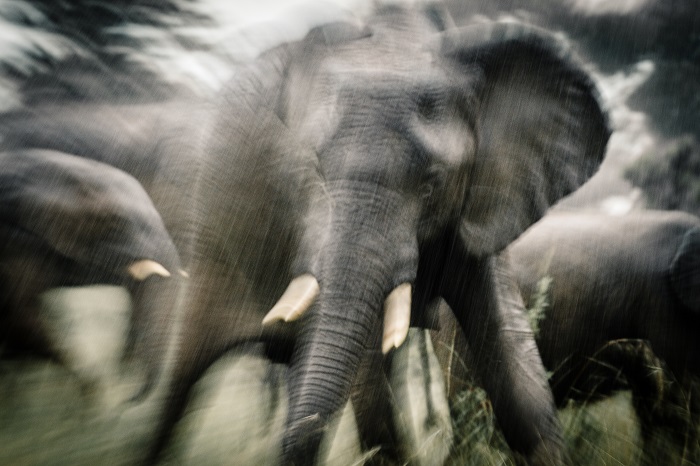
Note on miniumn age
Please note that we do not accept children under the age of twelve on this walking safari.
This seven day/six night safari includes
price does not include
Prices for our seven day/six night Loita Forest to Nashulai Maasai Conservancy Walking Safari vary on the number of people in your group and which of our Nashulai camps you choose to stay in.
Price based on one person starts at US$3080
Price based on two people sharing accommodation starts at US$4060.
Price based on four people sharing two double accommodation options starts at US$6650
Nashulai Maasai Conservancy Day Trips
Nashulai Maasai Conservancy is open for day visits. In order to maintain a minimal visitor footprint and ensure that everyone…
Nashulai Maasai Conservancy is open for day visits. In order to maintain a minimal visitor footprint and ensure that everyone visiting Nashulai has the highest quality safari experience, we do limit the number of day visitors and private non-Nashulai affiliated vehicles are not allowed into the conservancy. Everyone (excluding younger children) who visits the Nashulai Maasai Conservancy pays a set US$100per person/per day conservation and community development fee. The entirety of this money is used to fund the running of our conservancy and the various community development projects that we support. In addition to this conservation fee further charges are applied depending on the activities you wish to do.
There are several different ways to experience Nashulai Maasai Conservancy on a day visit.
Itinerary
These can be full of half-day safaris (morning or afternoon departure possible). A vehicle safari is the best option for those who want to see a wide variety of animals in a short space of time.
Our vehicle safaris are conducted in custom designed, open-sided safari jeeps perfectly kitted out for photographers. You will be accompanied by a Nashulai guide who will take pleasure in explaining everything that you see.

Half-Day Vehicle Safaris
Our half-day vehicle safaris generally concentrate on the part of the Nashulai Maasai Conservancy immediately abutting the Masai Mara National Reserve. Until a few years ago this was an area with no official protection and – thanks to human activities – the landscape was, in places, very degraded. Those people who saw it then wouldn’t recognise the area today. Large, grassy plains are interspersed with areas of dense bush and throughout there are rivers, streams and pools of water which act as natural wildlife magnets. The wildlife populations in this area, which were once very depleted have bounced back spectacularly since the creation of the conservancy and on a vehicle safari in this area you are certain to see large numbers of giraffe, zebra, baboons, impala, warthog, wildebeest and numerous other antelope and gazelle. Buffalo are commonly sighted as are hyenas and elephant. Of the cats there’s a resident pride of lions and cheetah are increasingly common.
During a half-day safari snacks and drinks will be provided.

Full Day Vehicle Safari
On a full-day safari you will have the chance to explore the large Nashulai East part of the conservancy. This area has a more varied terrain that includes richly fertile river valleys lined by yellow bark acacia and home to a wide-array of birdlife. There are also numerous hills covered in light woodland which is a real favourite of elephant and buffalo. In fact, Nashulai East sits squarely on an elephant migration corridor and is one of the best of the Mara conservancies in which to see these giant creatures. Herds of elephant thirty or more strong are common in this area. In the furthest corner of Nashulai East is the ‘secret plain’ a vast, open grassland where large numbers of grazers gather, including, in about January to March lots of wildebeest who come here to give birth. This abundance of prey means that the lion pride living here are commonly seen – and well fed!
During a full-day vehicle safari you will be given lunch either as a picnic to eat in the shade of an acacia tree or back at our Oldarpoi Camp. There will also be chances to do some short walks and to visit some of the Maasai communities living within the conservancy. There will be pauses throughout the day for snacks and drinks.

Day visitors to the Nashulai Maasai Conservancy have the option of doing a walking safari. You won’t get as close to the large animals as you do in a vehicle but being able to live, breath, smell, touch and hear the Kenyan bush is an unforgettable experience. You will also see all of the little creatures that would otherwise be missed by being confined to a vehicle. An expert walking guide will reveal the complexity of this eco-system to you and point out the birds, insects and other smaller creatures. You will also learn how to identify the different mammals from their tracks and learn about how the Maasai use the different plants in traditional medicines.
As well as a wildlife guide, on all of our walking safaris you will be accompanied by conservancy rangers.
For safety reasons children under the age of 12 are not allowed to partake in walking safaris although we can organise short family bush walks.
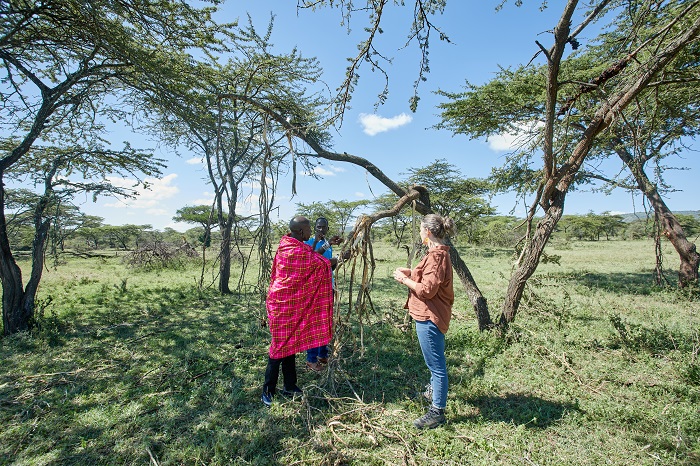
Half-Day Walking Safari
Our half-day walking safaris are conducted in the Nashulai Maasai Conservancy immediately abutting the Masai Mara National Reserve. The varied habitats within a short distance from one and other and large number of antelope, gazelle and zebra (who generally allow people on foot to approach to within fairly close quarters) make this a superb area for a walking safari. Although the pace is set by the clients, on most half-day walking safaris we start on the valley floor next to the river and a series of pools before heading gently uphill through bush and scrub to arrive on open grassland clearings to enjoy the often excellent wildlife viewing.
Drinks and snacks are provided on a half-day walking safari.
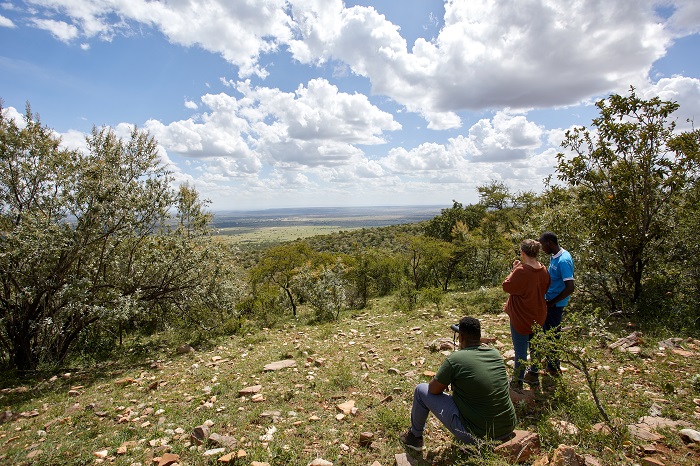
Full-Day Walking Safari
Our full-day walking safaris within the Nashulai Maasai Conservancy are a real once in a lifetime experience and we are the only conservancy offering regular, full day walking safaris. This adventurous activity takes place within the Nashulai East Conservancy and normally involve a 45min to one hour drive to our riverside drop off point. From here you will walk through the entire spectrum of Nashulai habitats. Passing firstly through areas of light human habitation where you can expect invitations to pause for a chat with some of the Maasai living here, and perhaps even an invitation into someone’s house to drink tea. There will be opportunities for bird and primate watching along the river banks, before starting a gentle upward climb through wildlife rich open woodland to arrive at remote grassland meadows at the base of a series of rocky hills. This is a beautiful area where elephant are often seen. We will pause here for lunch and a rest before climbing upward for a short distance to the crest of a small range of hills, which offer magnificent views over the entire conservancy and much of the Mara eco-system. Beyond these ridges to the east the environment is very different, as a vast open grassland plain unfolds around you. Wildlife here is abundant and easily seen. For most people this is the highlight of the full-day walking safari as you stroll across the plains being eyed by zebra, wildebeest and secretary birds. The walking safari ends at the far end of the plain near a small, traditional Maasai village where a vehicle will be waiting to return us back to camp.
A picnic lunch as well as snacks and drinks are provided.
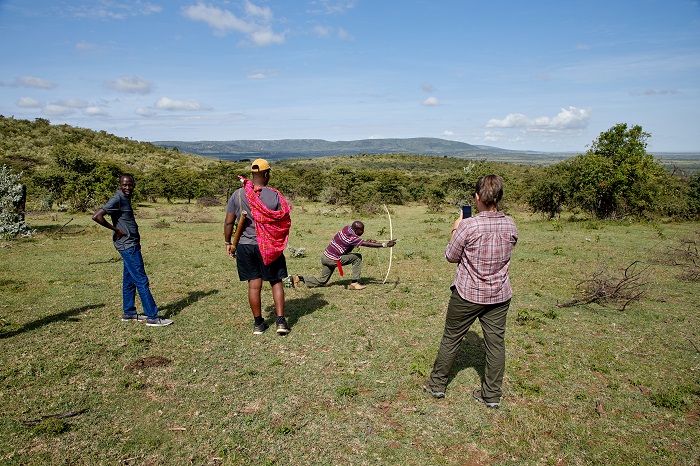
The focus of the Nashulai Maasai Conservancy is to make tomorrow better. We want to leave the Nashulai environment more ecologically rich for tomorrow’s generation than it is for todays. Therefore, we put great emphasis on encouraging children to explore, appreciate and understand the complex Nashulai eco-system, its plants and animals and how a healthy eco-system is good for us all. After-all, they are the decision makers of tomorrow. A Nashulai Maasai Family Adventure incorporates diverse activities that will please children of all ages. The exact range of activities will vary slightly depending on the age of your children and will be discussed with you in advance. Activities included might be
- A short bush walk in a safe area. During this your children will be introduced to some of the little creatures such as termites and dung beetles (every child loves a dung beetle!) and they will learn why such animals are so vital to the eco-system.
- Learn how to be a conservancy ranger by tracking larger mammals and identifying them via their poo (a sure fire favourite with every child!) and visiting the wildlife guide training college (older children only).
- Make a plaster cast of an animals footprint – maybe a zebra or an impala, or if they’re very lucky, a hyena or a lion. They will then be able to take the plaster cast home with them as a souvenir.
- Story time with an ex-poacher. Learn how the poachers survived in the bush, and be amazed by some of their adventures. But your children will also learn why poaching is such a threat.
- Picnic lunch in the bush. How many children can say they had lunch surrounded by giraffe?
- Warrior Training. Learn how to be a Maasai warrior, light a fire without matches (listen out kids: don’t repeat this at home!), make and use a bow and arrow and learn how to throw a spear properly.
- School visit. Just in case your child is disappointed at missing their maths lessons we can arrange for them to visit a local Maasai school and meet some of the teachers and children (available during school hours only).
- Meet the Maasai. See your children’s eyes pop with wonder when they visit a traditional Maasai manyatta and have a snack and drink with a Maasai mama.
- Plant a tree. Let your children leave Kenya a better place by planting a tree sapling (all trees used are native to this eco-system).
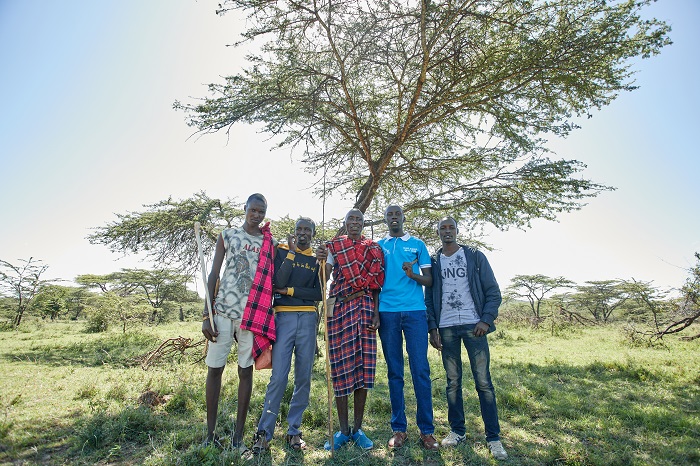
What is a wildlife conservancy? What good do they do? And, how do they operate? Get a behind the scenes view of a day in the life of a wildlife conservancy in Kenya. Learn about our conservation and community projects. Get a feel for the work of our dedicated rangers. Discover how we are training up the next generation of conservation managers. And meet the Nashulai community to hear their thoughts on the conservancy and visit the community health and education projects we have established.
This day long Conservation in Action programme will give you a solid grounding in the basics of community conservation in East Africa today and answer all the questions you might have about how a conservancy is run and the benefits it brings. As well as enjoying this privileged behind the scenes view you will also get the chance to do a short walking safari within the Nashulai Conservancy.
Lunch, which will be taken either with conservancy staff or students at our wildlife guide training college, is included in this full day experience.
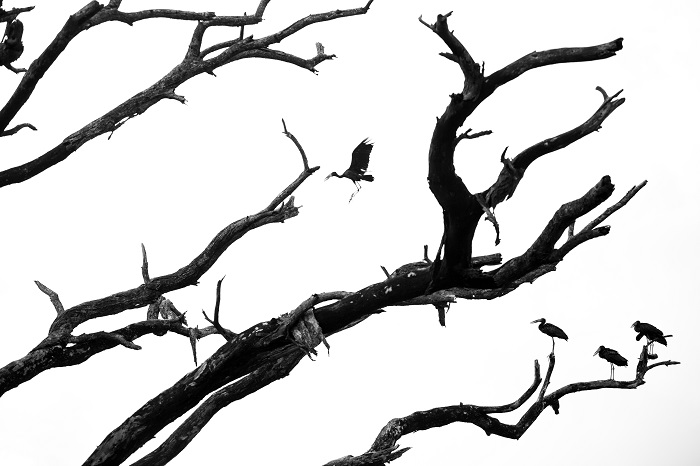 With its diverse range of habitats and position between the Masai Mara National Reserve, other conservancies, human habitation and the first up-welling of the Loita Hills, Nashulai Maasai Conservancy offers some of the finest bird-watching opportunities in the entire Mara eco-system.
With its diverse range of habitats and position between the Masai Mara National Reserve, other conservancies, human habitation and the first up-welling of the Loita Hills, Nashulai Maasai Conservancy offers some of the finest bird-watching opportunities in the entire Mara eco-system.
Our team of wildlife rangers and guides include dedicated, expert bird-watchers with in-depth knowledge of the conservancy’s avian life and where to search for key species.
Our Twitchers Experience runs on either half or full day basis within different parts of the Nashulai Maasai Conservancy. They are normally conducted using a mixture of driving and walking.
For the truly dedicated ornithologist we also offer multi day birding safaris across Kenya and elsewhere in East Africa. For more on these please contact us.
Nashulai Maasai Conservancy day visits include:
price does not include
Nashulai, the Masai Mara & The Forest of the Lost Child
To the east of the Nashulai Maasai Conservancy the land starts to rise up and changes dramatically. This is the Loita Hills. Far removed from the world of safari tourism, this stunning region of stumpy acacia woodlands, wide open plains, rich green farmland and cool, drizzly plateaus, is the last remaining corner of traditional Maasai culture in Kenya. As you venture further east things begin to change again. Slowly, the hills become mountains and soar two kilometres into the sky and it’s here that the Naimina Enkiyio forest – or Forest of the Lost Child – can be found. One of the most unique environments in Kenya, this wild region of dense rainforest pocked with thinly vegetated mountain summits gained its evocative name through a legend about a young Maasai girl who got lost in the forest whilst walking with her livestock. Despite an extensive hunt neither she, nor the livestock, were ever seen again.
Very few Kenyan’s, let alone foreign visitors, are aware of the existence of these hills and forests, and a visit to the Loita Hills and the Forest of the Lost Child is a true adventure into one of the most magical corners of East Africa.
Although the environment here is very different to that of the Masai Mara, these hills and forests are a vital part of the greater Mara-Serengeti eco-system and a key wildlife migration corridor between the Rift Valley and the Mara. The forests teem with buffalo and elephants, and leopard are also common. But, really you come here for what you can’t easily see in the Mara. These forests, which rise like sky islands, off the floor of the Rift Valley are full of animals more commonly associated with the jungles of Uganda and Central Africa. Beautiful colobus monkeys are everywhere and the birdlife is astounding. Even non-birders are amazed by the hornbills, with a wing beat that sounds like a passing helicopter, or the turacos (several species here) which look like a cross between a turkey and a parrot.
As well as being an oases for wildlife, these forests are culturally and religiously significant for the Maasai. The forests contain many sacred glades and are a source of herbs and plants used for traditional medication. The cultural importance has meant that the Maasai have strict social rules in place on exploiting the forest and this has allowed it to remain protected from deforestation and development. Nashulai Maasai Conservancy has been working closely with local community in this area and we are the only conservancy and safari company offering safaris in this region.
The nature of the environment here means that all explorations of the forest are done on foot. If you enjoy hiking – or simply want a break from being stuck in a vehicle – then you will love a walking safari in Loita. Using expert local guides (who have superb avian knowledge) you will be guided along forest trails to wildlife water holes, bird and primate watching spots, waterfalls and sublime viewpoints from where you can stare down to the Rift Valley, and across to Tanzania’s Lake Natron and beyond to the Crater Highlands.
Our standard tour (which really is anything but ‘standard’) is a six day adventure taking in Nashulai Maasai Conservancy, the Masai Mara National Reserve and the Loita hills and forest.
Itinerary
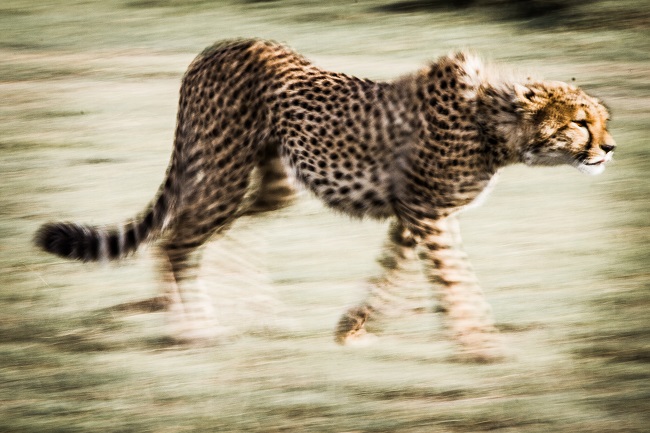 Arrive at Nashulai Maasai Conservancy and check into your luxury safari tent. After a three-course lunch set out on a safari within the Nashulai Maasai Conservancy in one of our customised safari vehicles to enjoy a wild chunk of East African wilderness virtually to yourself (only guests of Nashulai Maasai Safaris are allowed within the conservancy). The landscapes within the conservancy are very varied and a complete contrast to those of the nearby national reserve. Here, large, grassy plains are interspersed with areas of dense bush and throughout there are rivers, streams and pools of water which act as natural wildlife magnets. The wildlife populations in the conservancy are impressive, and you are certain to see large numbers of giraffe, zebra, baboons, impala, warthog, wildebeest and many more antelope and gazelle. Buffalo are commonly sighted as are hyenas and elephant. Of the cats there’s a resident pride of lions and cheetah are increasingly common.
Arrive at Nashulai Maasai Conservancy and check into your luxury safari tent. After a three-course lunch set out on a safari within the Nashulai Maasai Conservancy in one of our customised safari vehicles to enjoy a wild chunk of East African wilderness virtually to yourself (only guests of Nashulai Maasai Safaris are allowed within the conservancy). The landscapes within the conservancy are very varied and a complete contrast to those of the nearby national reserve. Here, large, grassy plains are interspersed with areas of dense bush and throughout there are rivers, streams and pools of water which act as natural wildlife magnets. The wildlife populations in the conservancy are impressive, and you are certain to see large numbers of giraffe, zebra, baboons, impala, warthog, wildebeest and many more antelope and gazelle. Buffalo are commonly sighted as are hyenas and elephant. Of the cats there’s a resident pride of lions and cheetah are increasingly common.
As the day draws to a close stop for a sundowner drink at a viewpoint inside the conservancy. Return to camp for a three course dinner.
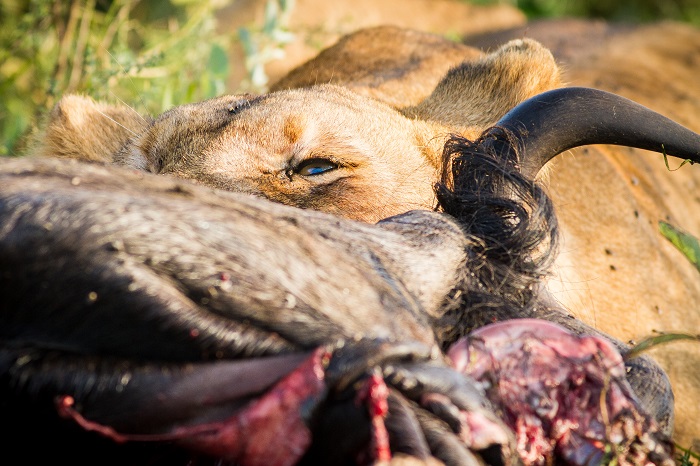 Your second day is dedicated completely to the Masai Mara National Reserve, a five minutes’ drive away from camp. After a big breakfast you will set out in one of our customised safari vehicles with an expert guide who has intimate knowledge of the Masai Mara National Reserve.
Your second day is dedicated completely to the Masai Mara National Reserve, a five minutes’ drive away from camp. After a big breakfast you will set out in one of our customised safari vehicles with an expert guide who has intimate knowledge of the Masai Mara National Reserve.
Our expert guide will reveal the wonder of the Mara grasslands to you. The Masai Mara is famous for its big cats. You would be very unlucky to not see at least one group of lions. Leopard and cheetah are both commonly seen as well. The other cats (caracals, servals and wild cats are present but very shy). You will also almost certainly see elephants often in sizeable herds. There are huge quantities of different antelope and gazelle (grants and Thompson gazelle, impala, and topi) and warthogs, zebra, giraffe, hyena, baboons and ostrich are everywhere. While the rivers are populated by crocodiles and hippos. Wildebeest are present year round but between July and early-October the population swells enormously as the million strong herds of migrating wildebeest arrive in the reserve from Tanzania’s Serengeti National park. Seeing such huge numbers of large mammals gathered together is a moment you’ll never forget.
For lunch on day two you can either have a picnic lunch within the reserve and spend the entire day out on safari. Or, you can return to camp for a three-course lunch followed by a rest and then either head back into the reserve for a late afternoon safari or you can do one of our cultural and conservation activities such as a short walking safari within the Nashulai Maasai Conservancy, or meet some of our rangers or visit a Maasai community among other options.
In the evening return to camp where you can enjoy a drink by the fire before a three-course dinner.
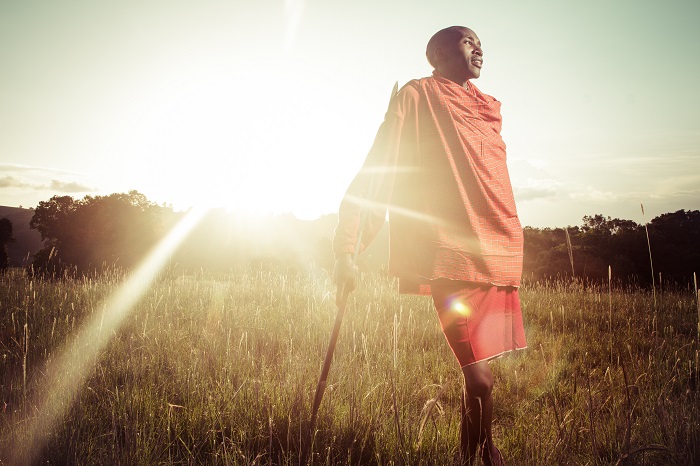 Your third day is dedicated completely to the Nashulai Maasai Conservancy. This time, after a filling breakfast you will set out to explore the Nashulai East Conservancy.
Your third day is dedicated completely to the Nashulai Maasai Conservancy. This time, after a filling breakfast you will set out to explore the Nashulai East Conservancy.
This area has very varied terrain that includes richly fertile river valleys lined by yellow bark acacia with excellent riverside bird-watching. There are also numerous hills covered in light woodland, which are a real favourite of elephant and buffalo. In fact, Nashulai East sits squarely on an elephant corridor and is one of the best of the Mara area conservancies in which to see these giant creatures. Herds of elephant thirty or more strong are common in this area. In the furthest corner of Nashulai East is the ‘secret plain’ a vast, open grassland with large numbers of grazers, including, in about January to March lots of wildebeest who come here to give birth. This abundance of prey means that the lion pride living here are commonly seen.
Depending upon your preferences, in the afternoon we can also include either a short bush walk, during which your guide will explain how the Maasai use the different plants for traditional medical practises and you’ll get to track the wildlife on foot. Or, we can take you to meet some our conservancy rangers and learn about the work of a conservancy and what their day to day role involves.
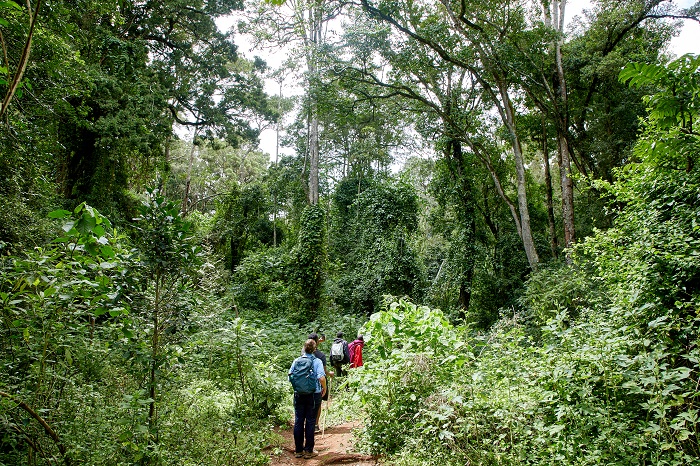
On day four we set out into one of the least known corners of Kenya. Rising up east of the Masai Mara and Nashulai, low scrubby hills (often, wrongly, called the Loita Hills). Slowly, slowly through ever changing landscapes the hills rise higher and the landscape turns greener and thicker until, eventually, you are in the Loita Hills proper and the so-called Forest of the Lost Child. Thick rainforest coats mountain slopes and huddles along river valleys while in other areas small villages and lone houses are surrounded by little terraced hillside fields of crops. This is the most traditional remaining corner of Kenyan Maasai lands and is unknown to most Kenyans never mind foreign visitors. The drive from Nashulai to our simple tented camp in the forest takes about four hours without stops. But, such as the beauty of the landscape on the way and the number of times that guests wish to stop and take it all in that the journey often ends up taking much longer.
On arrival at our camp though you’ll have a late lunch before setting out with our local guides, who are all expert birders and know the footpaths through the forest better than anyone, on a two hour hike (level of difficulty of the hike can be adjusted depending on requirements of the group). Bring binoculars in order to benefit from the spectacular bird-watching and to get closer views of the beautiful black and white colobus monkeys swinging through the trees.
Return to camp in the evening for dinner.
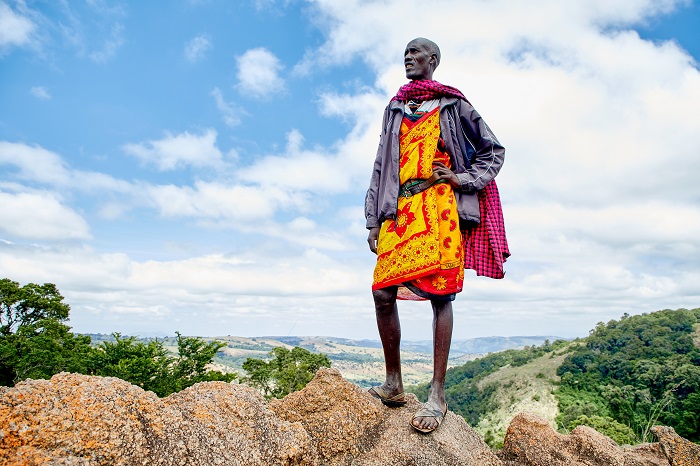
Today will likely be remembered as one of the highlights of your Kenyan adventure. A full-day will be spent hiking through the forests, up to lofty summits and through traditional Maasai villages where the welcome is warm and outside visitors rare. Our expert local guides will point out colobus monkey, hornbills, and turacos among a wealth of other bird and animal life. We will also walk to a waterhole deep in the forest where rust-red forest buffalo (a different species to the buffalo seen in the savannah plains), bushbuck, forest pigs and even elephant congregate for a drink. As well as wildlife, the walk takes in tiny farming villages where you will stop to talk to the local Maasai and maybe be invited inside their compounds to drink tea, and we will climb up to viewpoints to peer down towards Tanzania and the Rift Valley. A picnic lunch will be eaten in the forest or at one of the viewpoints. The exact length and difficulty of the walk can be tailored according to the ability and wishes of the group.
Heading back to our tented camp we will visit the small and very colourful local market town which brings in Maasai from across the region and even from nearby northern Tanzania.
There will be some time to relax and enjoy this wonderfully peaceful setting before sundowner drinks and dinner.

The exact schedule for today depends upon your plans after the safari ends. If you are returning straight to Nairobi for an international flight home then we will have a quick, early breakfast before a visit to a small swamp that has been restored from a previously degraded state to become a rich bird habitat. We will then drive back to Nairobi with a short pause for lunch at the Nashulai Maasai Conservancy. You will be dropped off either at a hotel of choice (not included in this package) in Nairobi or at the airport.
If, however, you have more time at your disposal then after the visit to the bird swamp we return to camp and visit some of the community projects that are part funded by our stay in Loita. These include an award-winning school and a very successful beading and jewellery project. After lunch we will return to Nashulai Maasai Conservancy where your safari ends. It’s also possible to return to Nashulai straight after breakfast and do an afternoon Nashulai or Masai Mara safari if this is preferred.
We also offer longer safaris in Loita with additional days spent walking between and camping in remote, wildlife-filled forest glades. All walking tours can be tailored to the hiking ability and interests of our guests. We can even cater for little walkers with family-friendly forest hikes and more time spent playing with other children in small villages.
This six day/five night safari includes
price does not include
Prices for our six day/five night Nashulai, Masai Mara & Forest of the Lost Child safaris vary on the number of people in your group and which of our Nashulai camps you choose to stay in.
Prices based on one person start at US$3450. Prices based on two people sharing accommodation start at US$4760.
The Nashulai Community and Conservation Experience
A safari in East Africa shouldn’t just be about wildlife. If you were to spend your entire time in East Africa hopping from one protected area to the next then there’s no doubt that you’d have some wonderful wildlife encounters. But, would you really have experienced the real East Africa?
At Nashulai Journeys we know that without local people the landscapes of East Africa are nothing. And so, we have created a journey based around the Nashulai Maasai Conservancy, where the focus is as much on community interaction and on providing a behind the scenes view of conservation in Kenya, as it is on wildlife viewing.
The experiences you have on this journey won’t be mere token glimpses of local life. You will be totally immersed within the community. You will even be hosted by a local Maasai family in a first of its kind homestay experience. In addition you will bushcamp in the conservancy and listen to the sound sof the wild all around you at night. You will learn how a conservancy operates and the advantages it brings to a community. You will talk to members of the community, go to church and school with them, take the livestock out to grazing, and visit a number of local community improvement projects.
But don’t worry, this safari does still give you time to tick off the lions and giraffes. A full day will be spent on safari in the nearby Masai Mara National Reserve, as well as half-day safaris within Nashulai Maasai Conservancy and you will experience the thrill of a walking safari and go out on patrol with conservancy rangers.
And at the end of it all we feel safe in saying that you will leave Nashulai with new friends who you might well stay in touch with for years afterwards. And what can be more rewarding than that?
We have purposefully tried to keep costs down on this journey so as to make it more affordable to those we believe will most appreciate it. In order to do this we are using more basic accommodation, walking rather than driving as much as we can and quoted prices don’t include transfers to/from Nairobi or any alcoholic drinks.
Itinerary
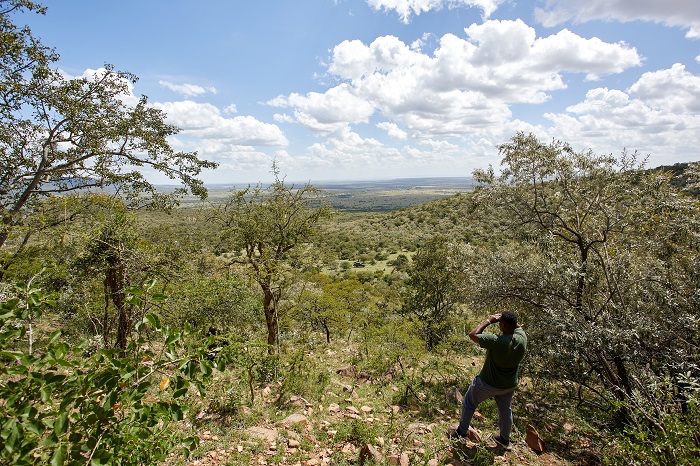
Unlike with most of our tours and safaris there is no vehicle or air transfer from Nairobi or elsewhere in Kenya included in our budget community safari. You can make your way to Sekenani village, which is by the main entrance to the Masai Mara National Reserve under your own steam using bus, plane or rental vehicle from Nairobi. We can advise on public transport travel. At extra cost we can include a private transfer from Nairobi. One of our team will meet you in Sekenani and take you to meet the Maasai family who will be hosting you during your stay. After a healthy, home-made lunch we will head deep into the conservancy on a driving safari, which will be conducted in a customised safari vehicle. This will be exactly the same kind of safari experience that Nashulai guests staying in one of our higher end camps receives. An expert local guide will accompany you and sundowner drinks will take place within the conservancy. A safari within the conservancy is an exclusive experience. Only Nashulai guests are allowed to go on safari here which ensures very limited visitor numbers and no crowding of vehicles around a single sighting. On your safari you can expect to see large numbers of different antelope and gazelle, lots of zebra and giraffe as well as wildebeest, buffalo, warthog and baboon. Hyena are commonly encountered, as are elephant and lion and cheetah are being seen with increasing frequency. Leopard are present but very shy and the bird life is astounding. Return to your host family for dinner.
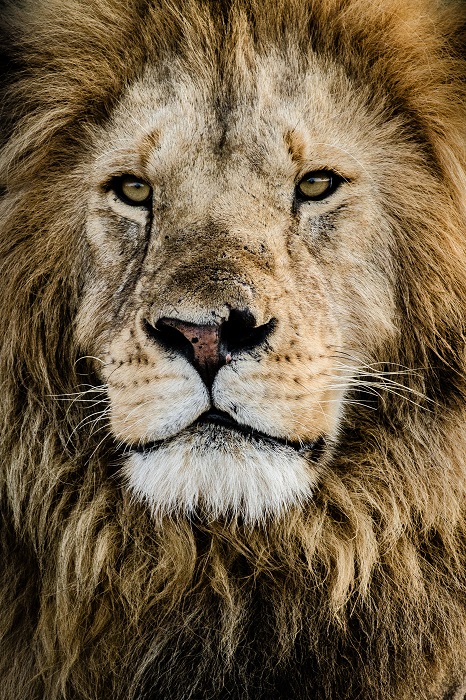 Today is devoted entirely to the world famous Masai Mara National Reserve. Our expert guide will reveal the wonder of the Mara grasslands to you. The Masai Mara is famous for its big cats and you would be very unlucky to not see at least one group of lions. Leopard and cheetah are both commonly seen. The other cats (caracals, servals and wild cats) are present but very shy. You will also almost certainly see elephants, often in sizeable herds. There are huge quantities of different antelope and gazelle (grants and Thompson gazelle, impala, and topi) and warthogs, zebra, giraffe, hyena, baboons and ostrich are everywhere. While the rivers are populated by crocodiles and hippos. Wildebeest are present year round but between July and early-October the population swells enormously as the million strong herds of migrating wildebeest arrive in the reserve from Tanzania’s Serengeti National Park. Seeing such huge numbers of large mammals gathered together is a moment you’ll never forget.
Today is devoted entirely to the world famous Masai Mara National Reserve. Our expert guide will reveal the wonder of the Mara grasslands to you. The Masai Mara is famous for its big cats and you would be very unlucky to not see at least one group of lions. Leopard and cheetah are both commonly seen. The other cats (caracals, servals and wild cats) are present but very shy. You will also almost certainly see elephants, often in sizeable herds. There are huge quantities of different antelope and gazelle (grants and Thompson gazelle, impala, and topi) and warthogs, zebra, giraffe, hyena, baboons and ostrich are everywhere. While the rivers are populated by crocodiles and hippos. Wildebeest are present year round but between July and early-October the population swells enormously as the million strong herds of migrating wildebeest arrive in the reserve from Tanzania’s Serengeti National Park. Seeing such huge numbers of large mammals gathered together is a moment you’ll never forget.
For lunch you can either have a picnic lunch within the reserve and spend the entire day out on safari (this is what we recommend you do). Or, you can return to the homestay for lunch followed by a rest and then head back into the reserve for a late afternoon safari.
Evening dinner with your hosts at the homestay.

Now you’ve met the animals who live in the Mara eco-system it’s time to get a deeper understanding of how people and groups are working to protect the environment of southern Kenya. After breakfast we will head to the Nashulai Maasai Conservancy headquarters to meet some of the staff and rangers where they will explain how the conservancy functions, how the model differs from a national park and or reserve and what the benefits are to local communities and the environment. If your visit takes place on a weekday during term time you will also get to visit the Nashulai Wildlife Training College where future conservancy rangers, managers and staff are trained. You will be able to chat to some of the students and staff. You will then head out on a short patrol with conservancy staff or get to visit one of the nearby Nashulai conservation projects. The exact nature of the visit will depend on what work is taking place on the day of your visit. A local lunch will be taken with college students or conservancy staff.
In the afternoon we will set out on a walking safari through the conservancy. This is one of the most thrilling of all Nashulai experiences. As you stride through the bush zebra, and impala will eye you with caution, warthog will flee with radar like tails head aloft and giraffe will peer quizzically down on you from on up high. There is the possibility of encountering larger and more dangerous creatures such as elephant and buffalo so an armed ranger will be with us at all times. By late afternoon we will have arrived at our chosen camping spot where small dome tents will be put up, a fire lit and dinner and drinks served to an African sunset. We will go to sleep early to the sounds of the African savannah all around us. An armed guard will be with us all night and, for safety reasons, strict rules will apply on getting out of your tent in the middle of the night!
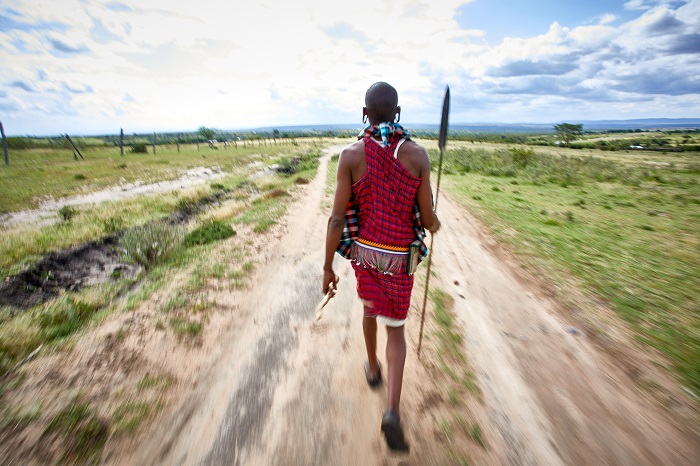
The birds dawn chorus will wake us and a simple breakfast of tea or coffee and mandazis (a local donut commonly eaten at breakfast time) will be eaten as the grasslands wake up. After packing up the camp we will join our armed guard to walk back to the homestay. On the way there will likely be many wildlife sightings, but remember that it’s not just about the large mammals and your guide will be sure to point out some of the diverse birdlife, interesting insects and with luck colourful lizards, small frogs and even one of the amazing chameleons will be seen.
After lunch we will visit some of the conservancy funded community projects in the surrounding villages and learn how wildlife tourism money is used to improve lives. There are various project options for this visit and what we see and do will vary depending on the day and what is taking place then. But, these visits could include sitting in on a womens empowerment meeting, school visits, and learning about the clinic and orphanage where there might be a chance to meet some of the children. Many of these orphans are not technically orphans but are young girls who have run away from their family in order to avoid a forced marriage (forced marriages are illegal in Kenya but continue in remote areas).
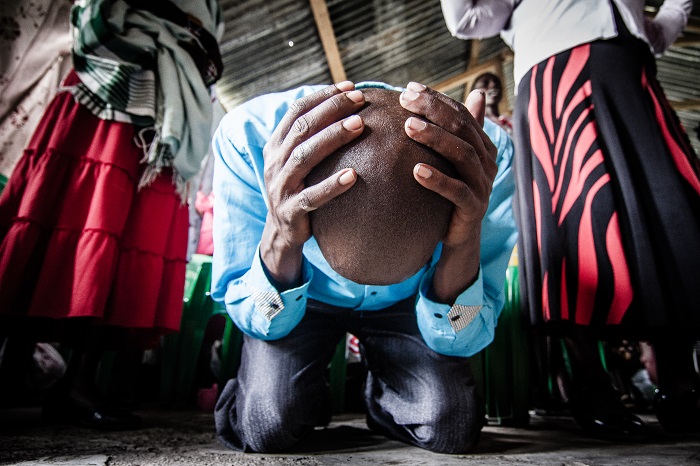 This morning you will be given a choice of activities. You can either join the conservancy rangers on their patrols and helping with other day to day tasks (which could be anything from listening in to a community meeting, clearing riverbanks of rubbish, or helping with wildlife surveys). Or, you can go on a bird watching walk close to Sekenani village with an expert birding guide. The third option is to continue to spend time with the local Maasai community. If it’s a Sunday morning we highly recommend joining in the local church service and also learning something of the old Maasai religion of Enkai, which today has been largely replaced with Christianity. A Kenyan church service is a highly colourful (and often noisy) spectacle. There will also be the chance to join the local women at the jewellery beading project where you can even try your hand at making traditional Maasai jewellery and talk to the women about the power a little financial independence has given them.
This morning you will be given a choice of activities. You can either join the conservancy rangers on their patrols and helping with other day to day tasks (which could be anything from listening in to a community meeting, clearing riverbanks of rubbish, or helping with wildlife surveys). Or, you can go on a bird watching walk close to Sekenani village with an expert birding guide. The third option is to continue to spend time with the local Maasai community. If it’s a Sunday morning we highly recommend joining in the local church service and also learning something of the old Maasai religion of Enkai, which today has been largely replaced with Christianity. A Kenyan church service is a highly colourful (and often noisy) spectacle. There will also be the chance to join the local women at the jewellery beading project where you can even try your hand at making traditional Maasai jewellery and talk to the women about the power a little financial independence has given them.
After lunch we set out on what, for many guests, turns out to be the absolute highlight of their African adventure: a Maasai village homestay experience. The village we will be staying at is on the furthest fringes of the conservancy and far from the Masai Mara National Reserve and its associated tourism industry. None of the people you meet here will be dressed up as ‘moran’ (warriors) as is common at tourist cultural villages. This is a real, living, contemporary Maasai village in a remote corner of Kenya and the experience of staying here will give you a genuine look at day to day Maasai life. The village we normally stay at is set halfway up a low hill that overlooks a vast grassland plain that often teems with wildlife (including, in about February, large numbers of Loita wildebeest who come to these short grass plains to give birth). There are also resident lions who are frequently seen and elephant are very common in the woodlands just above the village. Although we will use a vehicle to reach the village the last part of the journey, up and over the crest of a hill and down to the village, will be done on foot. On arrival at the village we will meet our hosts and explore the village. As the sun starts to set the livestock will return fro, the pastures and you can help to do the milking and ensure that all the anials are safely locked away in the boma for the night. Then there is cooking to be done as evening meals need preparing for everyone. You can help one of the Maasai mammas prepare dinner for everyone. Afterwards there is often much story-telling before everyone goes early to bed. Due to space and privacy issues most of the time you won’t actually sleep with the family in their hut but in a small two man dome tent next to a house.
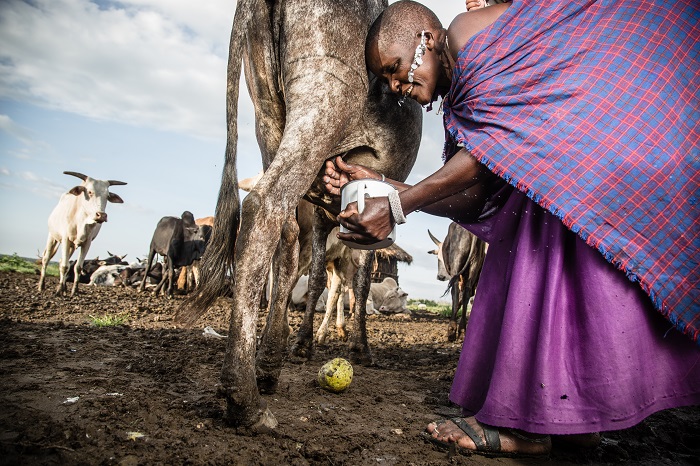
Days start early in the Maasai village and shortly after dawn we will be up and helping to milk the livestock and prepare breakfast. You will then set out with the herds of livestock to the grazing grounds where you will spend some time experiencing the life of a Maasai shepherd. When it gets too hot we will return to the village and say our goodbyes before returning by vehicle to the main Nashulai camp where lunch will be served. The tour ends after lunch. We can help you arrange a seat on public transport back to Nairobi or supply a private vehicle (extra charge).
Note on Safari Duration and Accommodation
The safari described here can be either shortened or lengthed depending on your requirements. In order to keep costs down you will be given a choice of accommodation. You can sleep in a spacious Nashulai dome tent and we will provide you with a mattress on the floor and bedding as well as a small table and chairs and a lamp. Or, to reduce costs further you can bring your own camping equipment and set up camp under the shade of big trees on our grassy camping area. In either case, toilets and showers are in a shared block. Meals are included as a part of the overall package and will be taken in the restaurant of our Oldarpoi Camp. Alcoholic drinks are not included. As much as possible we will get around on foot as this reduces the cost to you or having a vehicle on stand-by.
This six day/five night safari includes
price does not include
Prices for our six day/five night community safaris depend on the number of people in your group. Prices for a community Nashulai Conservation safari, based on one person travelling alone start from US$2380. Prices for two people sharing accommodation start at US$3760 for two people.
Three Day Safari: Nashulai Maasai Conservancy & Masai Mara National Reserve
One of our most popular short safaris, this three day extravaganza gives you the best of the Mara region. You will go on vehicle safaris within the Masai Mara national Reserve and Nashulai Maasai Conservancy plus there will be bush picnics, short walks and the chance to learn a bit about conservation in Kenya today.
Itinerary
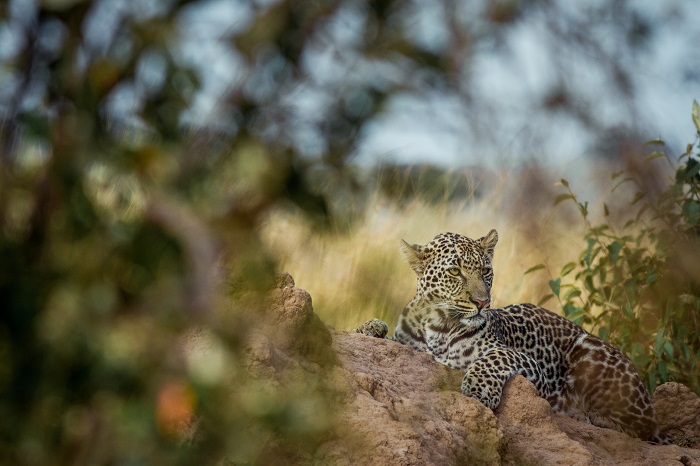 Arrive at Nashulai Maasai Conservancy and check into your luxury safari tent. After a three-course lunch set out on a safari within the Nashulai Maasai Conservancy in one of our customised safari vehicles to enjoy a wild chunk of East African wilderness virtually to yourself (only guests of Nashulai Maasai Safaris are allowed within the conservancy). The landscapes within the conservancy are very varied and a complete contrast to those of the nearby national reserve. Here, large, grassy plains are interspersed with areas of dense bush and throughout there are rivers, streams and pools of water which act as natural wildlife magnets. The wildlife populations in the conservancy are impressive, and you are certain to see large numbers of giraffe, zebra, baboons, impala, warthog, wildebeest and many more antelope and gazelle. Buffalo are commonly sighted as are hyenas and elephant. Of the cats there’s a resident pride of lions and cheetah are increasingly common.
Arrive at Nashulai Maasai Conservancy and check into your luxury safari tent. After a three-course lunch set out on a safari within the Nashulai Maasai Conservancy in one of our customised safari vehicles to enjoy a wild chunk of East African wilderness virtually to yourself (only guests of Nashulai Maasai Safaris are allowed within the conservancy). The landscapes within the conservancy are very varied and a complete contrast to those of the nearby national reserve. Here, large, grassy plains are interspersed with areas of dense bush and throughout there are rivers, streams and pools of water which act as natural wildlife magnets. The wildlife populations in the conservancy are impressive, and you are certain to see large numbers of giraffe, zebra, baboons, impala, warthog, wildebeest and many more antelope and gazelle. Buffalo are commonly sighted as are hyenas and elephant. Of the cats there’s a resident pride of lions and cheetah are increasingly common.
As the day draws to a close stop for a sundowner drink at a viewpoint inside the conservancy. Return to camp for a three course dinner.
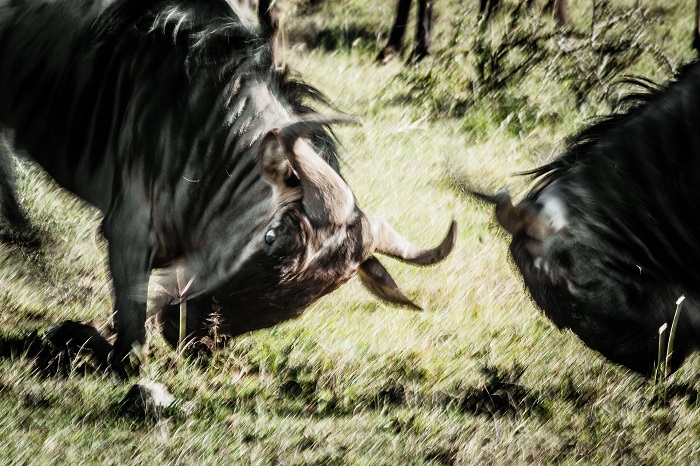 Your second day is dedicated completely to the Masai Mara National Reserve, a five minutes’ drive away from camp. After a big breakfast you will set out in one of our customised safari vehicles with an expert guide who has intimate knowledge of the Masai Mara National Reserve.
Your second day is dedicated completely to the Masai Mara National Reserve, a five minutes’ drive away from camp. After a big breakfast you will set out in one of our customised safari vehicles with an expert guide who has intimate knowledge of the Masai Mara National Reserve.
Our expert guide will reveal the wonder of the Mara grasslands to you. The Masai Mara is famous for its big cats. You would be very unlucky to not see at least one group of lions. Leopard and cheetah are both commonly seen as well. The other cats (caracals, servals and wild cats are present but very shy). You will also almost certainly see elephants often in sizeable herds. There are huge quantities of different antelope and gazelle (grants and Thompson gazelle, impala, and topi) and warthogs, zebra, giraffe, hyena, baboons and ostrich are everywhere. While the rivers are populated by crocodiles and hippos. Wildebeest are present year round but between July and early-October the population swells enormously as the million strong herds of migrating wildebeest arrive in the reserve from Tanzania’s Serengeti National park. Seeing such huge numbers of large mammals gathered together is a moment you’ll never forget.
For lunch on day two you can either have a picnic lunch within the reserve and spend the entire day out on safari. Or, you can return to camp for a three-course lunch followed by a rest and then either head back into the reserve for a late afternoon safari or you can do one of our cultural and conservation activities such as a short walking safari within the Nashulai Maasai Conservancy, or meet some of our rangers or visit a Maasai community among other options.
In the evening return to camp where you can enjoy a drink by the fire before a three-course dinner.
 Your third day is dedicated completely to the Nashulai Maasai Conservancy. This time, after a filling breakfast you will set out to explore the Nashulai East Conservancy.
Your third day is dedicated completely to the Nashulai Maasai Conservancy. This time, after a filling breakfast you will set out to explore the Nashulai East Conservancy.
This area has very varied terrain that includes richly fertile river valleys lined by yellow bark acacia with excellent riverside bird-watching. There are also numerous hills covered in light woodland, which are a real favourite of elephant and buffalo. In fact, Nashulai East sits squarely on an elephant corridor and is one of the best of the Mara area conservancies in which to see these giant creatures. Herds of elephant thirty or more strong are common in this area. In the furthest corner of Nashulai East is the ‘secret plain’ a vast, open grassland with large numbers of grazers, including, in about January to March lots of wildebeest who come here to give birth. This abundance of prey means that the lion pride living here are commonly seen.
Depending on what time you are scheduled to leave Nashulai for your next destination we can also include either a short bush walk, during which your guide will explain how the Maasai use the different plants for traditional medical practises and you’ll get to track the wildlife on foot. Or, we can take you to meet some our conservancy rangers and learn about the work of a conservancy and what their day to day role involves.
This three day/two night safari includes
price does not include
Prices for our three day/two night safaris vary on the number of people in your group and which of our two camps you choose to stay in.
A three day/two night safari based on a single person travelling alone starts from US$1725. A three day/two night safari based on two people sharing accommodation starts at US$2520.
Two Day Nashulai Maasai Conservancy & Masai Mara National Reserve Safari
If you only have two days to spare then this short tour gives you an intense overview of both the award-winning Nashulai Maasai Conservancy and the famed Masai Mara National Reserve.
Itinerary
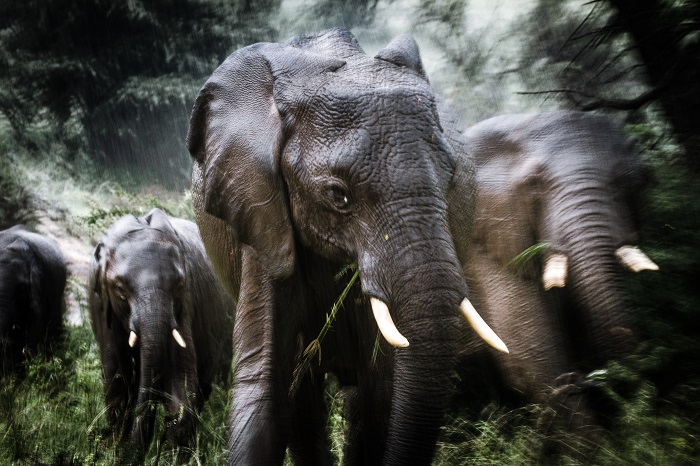 Arrive at Nashulai Maasai Conservancy and check into your luxury safari tent. After a three-course lunch set out for an afternoon and early evening vehicle safari in the nearby Masai Mara National Reserve. The main entrance is only five minutes’ drive away.
Arrive at Nashulai Maasai Conservancy and check into your luxury safari tent. After a three-course lunch set out for an afternoon and early evening vehicle safari in the nearby Masai Mara National Reserve. The main entrance is only five minutes’ drive away.
Our expert guide will reveal the wonder of the Mara grasslands to you. The Masai Mara is famous for its big cats. You would be very unlucky to not see at least one group of lions. Leopard and cheetah are both commonly seen as well. The other cats (caracals, servals and wild cats are present but very shy). You will also almost certainly see elephants often in sizeable herds. There are huge quantities of different antelope and gazelle (grants and Thompson gazelle, impala, and topi) and warthogs, zebra, giraffe, hyena, baboons and ostrich are everywhere. While the rivers are populated by crocodiles and hippos. Wildebeest are present year round but between July and early-October the population swells enormously as the million strong herds of migrating wildebeest arrive in the reserve from Tanzania’s Serengeti National park. Seeing such huge numbers of large mammals gathered together is a moment you’ll never forget.
Returning to camp you can enjoy a drink by the fire before a three-course dinner
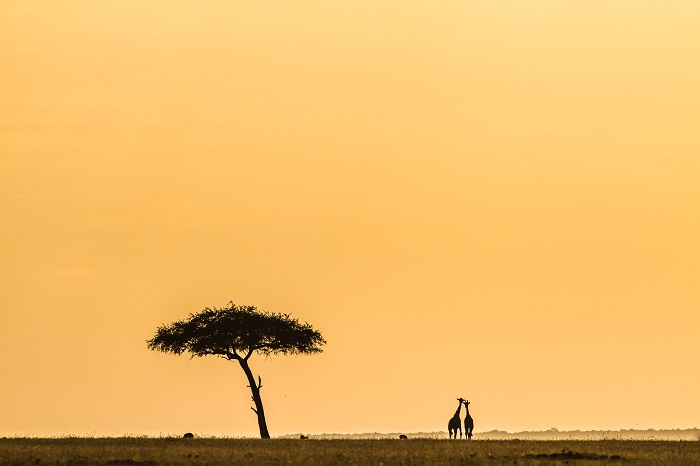 Your second day is dedicated completely to the Nashulai Maasai Conservancy. After a big breakfast head out in one of our customised safari vehicles to enjoy a wild chunk of East African wilderness virtually to yourself (only guests of Nashulai Maasai Safaris are allowed within the conservancy). The landscapes within the conservancy are very varied and a complete contrast to those of the nearby national reserve. Here, large, grassy plains are interspersed with areas of dense bush and throughout there are rivers, streams and pools of water which act as natural wildlife magnets. The wildlife populations in the conservancy are impressive, and you are certain to see large numbers of giraffe, zebra, baboons, impala, warthog, wildebeest and many more antelope and gazelle. Buffalo are commonly sighted as are hyenas and elephant. Of the cats there’s a resident pride of lions and cheetah are increasingly common.
Your second day is dedicated completely to the Nashulai Maasai Conservancy. After a big breakfast head out in one of our customised safari vehicles to enjoy a wild chunk of East African wilderness virtually to yourself (only guests of Nashulai Maasai Safaris are allowed within the conservancy). The landscapes within the conservancy are very varied and a complete contrast to those of the nearby national reserve. Here, large, grassy plains are interspersed with areas of dense bush and throughout there are rivers, streams and pools of water which act as natural wildlife magnets. The wildlife populations in the conservancy are impressive, and you are certain to see large numbers of giraffe, zebra, baboons, impala, warthog, wildebeest and many more antelope and gazelle. Buffalo are commonly sighted as are hyenas and elephant. Of the cats there’s a resident pride of lions and cheetah are increasingly common.Depending on what time you are scheduled to leave Nashulai for your next destination we can also include either a short bush walk, during which your guide will explain how the Maasai use the different plants for traditional medical practises and you’ll get to track the wildlife on foot. Or, we can take you to meet some our conservancy rangers and learn about the work of a conservancy and what their day to day role involves.
This two day/one night safari includes
- International flights
- Visas for Kenya or any third country
- Transportation to/from home departure airport
- Souvenirs
- Laundry service
- Tips
- Premium alcoholic drinks
- Travel insurance
Prices for our two day/one night safaris vary on the number of people in your group and which of our two camps you choose to stay in.
A two day/one night safari based on a single person travelling alone starts from US$1210. A two day/one night safari based on two people sharing accommodation starts at US$1790 for two people.
